LIVING
GIVING BACK
PEOPLE
SHOULD KNOW
OF DESIRE
EQ GIFT GUIDE


NOVEMBER/DECEMBER 2022 EQ EQLiving.com PEOPLE | TRAVEL | DESIGN | FASHION | STYLE | D É COR
UESTRI AN NOVEMBER/DECEMBER 2022 DISPLAY UNTIL JAN 2, 2023 EQUESTRIAN LIVING EQ ®
FOUR
YOU
OBJECTS
LUXE CASHMERE BOOTS FOR SHOW HOLIDAY SPIRIT DÉCOR IDEAS
Ransome Rombauer at her family's home and vineyards in California.




Your barn is the setting of your horse’s story. We ensure every ride, every bath, every moment is a chapter to remember.


Right or Not at All

717.687.0292 | BandDBuilders.com Built
FEATURES
RANSOME ROMBAUER
Growing up in wine country, Ransome Rombauer found a love of riding, which has evolved into a quickly growing show-jumping career. Her enthusiasm for rescuing animals has also grown, from miniature horses to dogs and kill pen horses.

CECE BLOUM
Accomplished horsewoman and daughter of the famous entertainer Jimmy Durante, CeCe Bloum’s work has shifted from her successful horse business at Newmarket Farm to her mission with Thrive Animal Rescue in Del Mar, California.
LYNN COAKLEY
As founder of the EQUUS Foundation, Lynn Coakley has changed the equestrian world with the wide scope of her philanthropic goals. She aims to improve the world of horses and people by bringing attention to the plight of horses in need and helping to connect people and horses together.
JULIE HOLZBERGER
After a 25-year-long break, Julie Holzberger is back in the saddle, with insights for others on what to expect in terms of success and finding balance in life, while embodying a deep commitment to philanthropy.
A DAIRY BARN DREAM RENOVATION
The owner and designer of King Barns, John King, explains the finer details of a renovation project, in which preservation was of paramount importance. With a highlight on history and natural elements, the resulting building is stunning and welcoming.
THE DYNAMIC PAINTINGS OF SARAH PAYNE
Sarah Payne’s background in photography and design led her to discover her skill for painting during the COVID lockdown. With a classic style and a minimal color palette, her large-scale equine portraits are gaining notice across the art world.

84 THE DYNAMIC PAINTINGS OF SARAH PAYNE
NOVEMBER | DECEMBER 2022
50
60
68
74
80
84
74 JULIE HOLZBERGER 4 | EQUESTRIAN LIVING | NOVEMBER/DECEMBER | 2022 EQ INSIDEEQ INSIDE
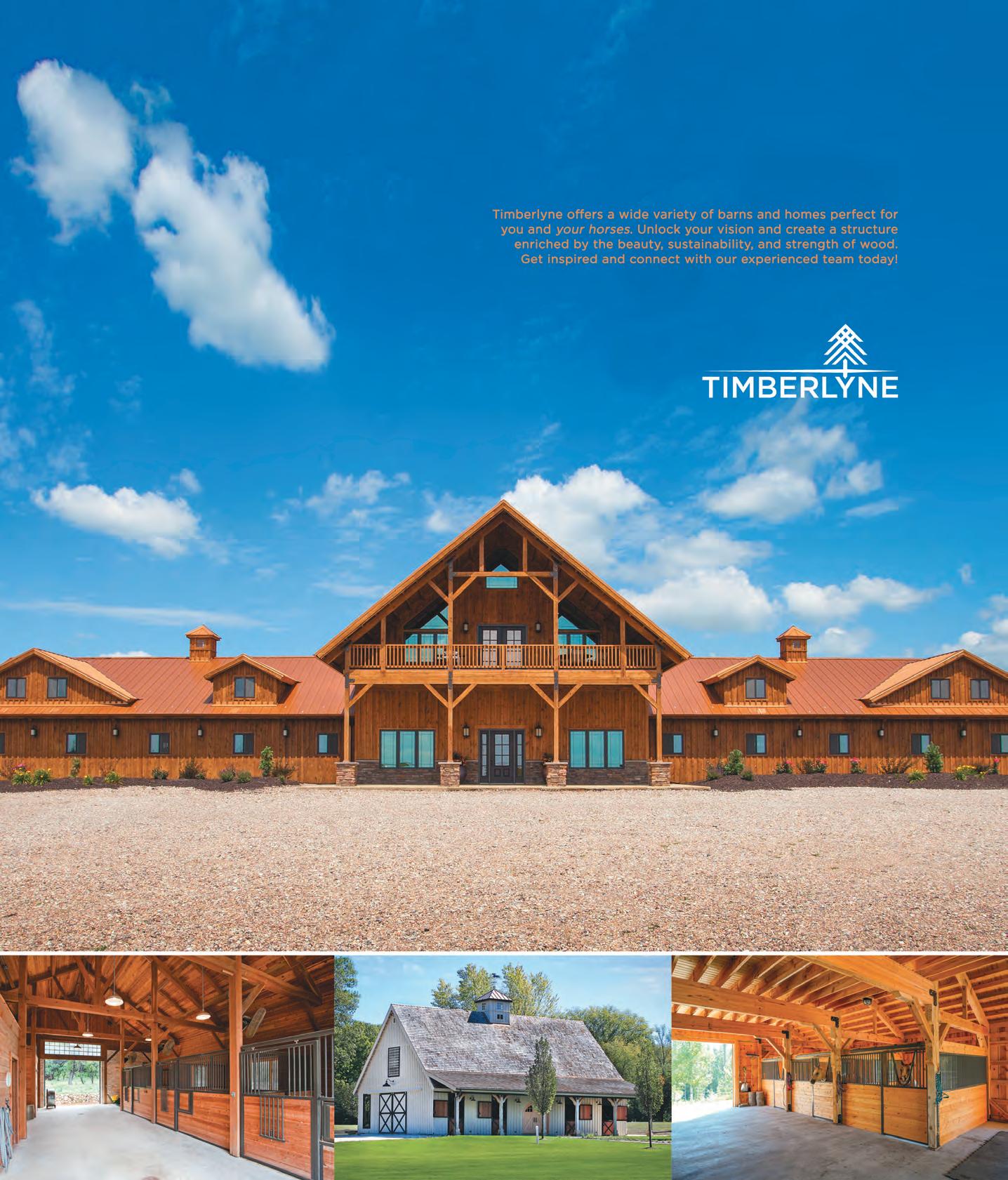


Show jumper and animal rescuer Ransome Rombauer
photographed
location in Napa Valley, California, by photographer Chase Hall.
full feature, see page
DEPARTMENTS
EACH
EDITOR’S
Look
the
CONTACT INFO | PAGE 92 to
in this issue.
BARN DOGS
The Torano family’s adopted dogs have made
dog person out of famous horseman Jimmy Torano.
FAVORITES
Margie Engle discusses her favorites, from restaurants and books to horses and shows.

Holiday gift ideas for everyone in your life.
Read an excerpt from For the Love of the Horse by Mark Rashid.
Beautiful weather met exciting competition at this year’s Reining by the Bay.
A series of children’s chapter books inspire kids with true stories of rescued dogs.
DÉCOR
Cozy up this season with these holiday décor ideas.
FASHION
Wrap yourself in the casual comfort of cashmere and alpaca.

Step into the show ring in polished style with this selection of performance tall boots.

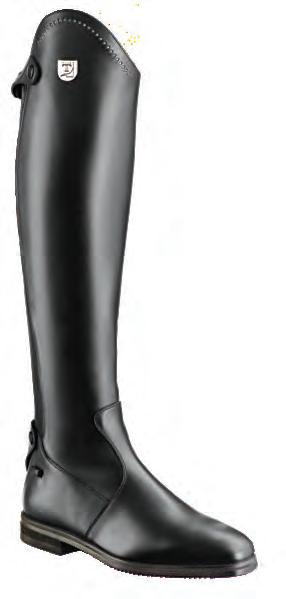
FOOD + DRINK
Executive pastry chef of the Prince and the Pauper in Woodstock, Vermont, shares a favorite dessert recipe.

PEOPLE
Yoga expert and YouTube sensation Kassandra Reinhardt shares her experience and the benefits of yoga for riders.
STYLE
Three brands steeped in rich equestrian heritage offer objects of desire.

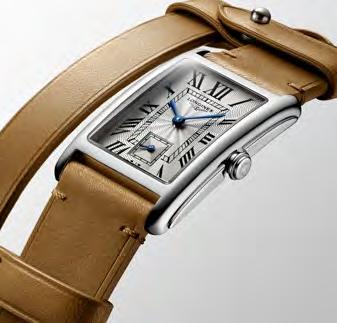
TRAVEL
A personal travel diary captures an equestrian’s trip to Albania.
EQUESTRIAN TECH
Prixview is changing the equestrian industry by gathering data and creating fantasy games.
NOVEMBER | DECEMBER 2022
was
on
For
50. ON THE COVER IN
ISSUE
NOTE 8 Welcome to Equestrian Living RESOURCES 92
for
find
products and services
98
a
35 26
12
14
36
40
44
22
24
30
26
34
35
42
48
6 | EQUESTRIAN LIVING | NOVEMBER/DECEMBER | 2022 EQ INSIDEEQ INSIDE
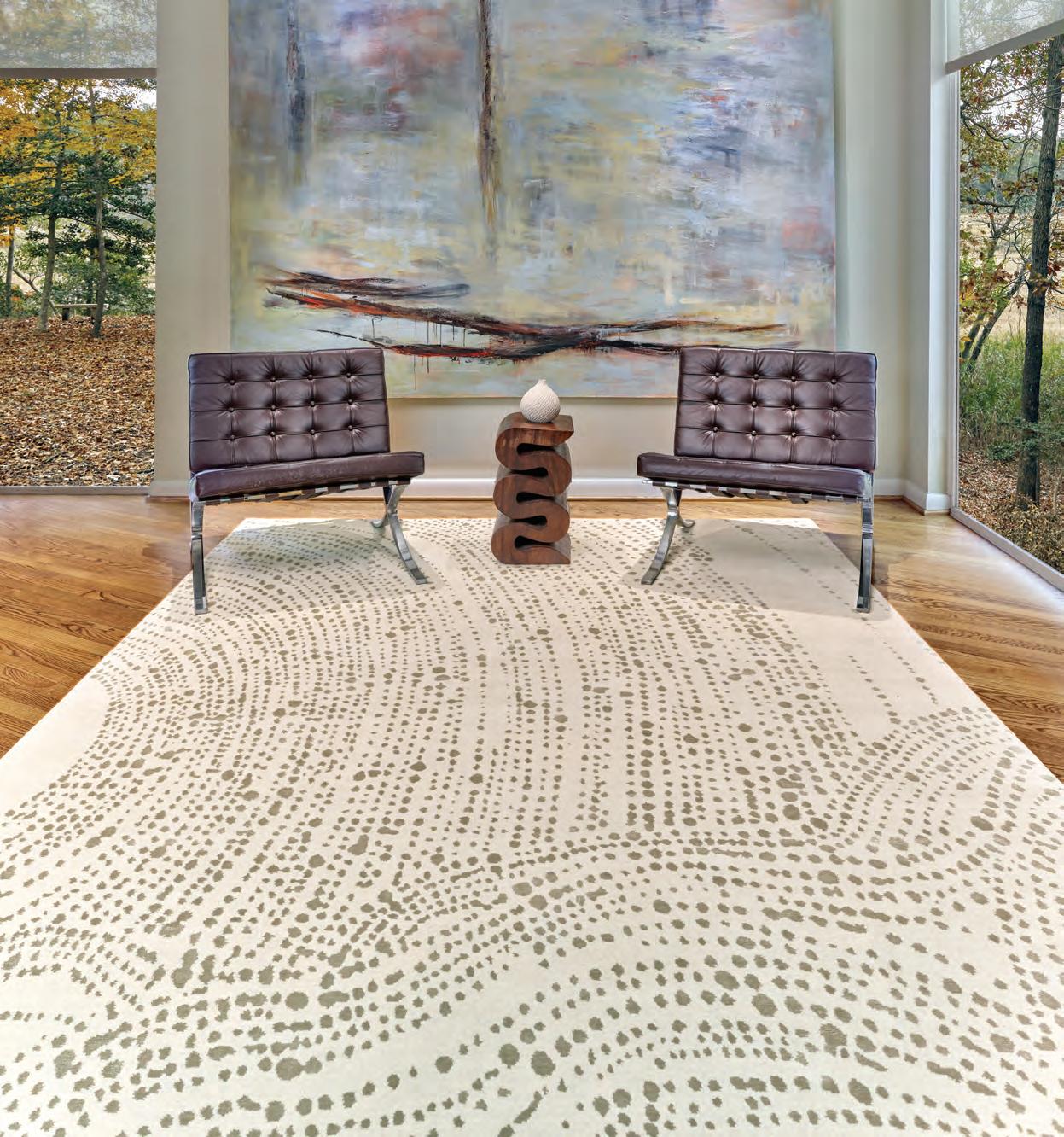
On location in Wellington, Florida. From left: hair and make-up artist Leslie Munsell, Ransome Rombauer’s mother, Laura Rombauer, Ransome Rombauer, and Equestrian Living editor Stephanie Peters.

Acts of heroism and kindness are an often-repeated story, and I intend to add a few more to the uplifting topic in this letter.
Unlike in the past few issues, which reflected the pandemic’s lin gering impacts, I expected the tone of this letter to have a jauntier lilt as I introduced readers to four philanthropically minded individuals and touched on their inspira tional and diverse giving-back endeavors. But my plan changed course.

By now, many equestrians have read about the extraordinary generosity of the World Equestrian Center (WEC), a world-class equestrian complex in Ocala, Florida. But for those a bit removed from the equestrian world, particularly in Florida, the scope of WEC’s outreach
was enormous. As Ian, the cat egory four hurricane, took aim at Florida’s southwest coast, WEC’s Equestrian Hotel and extensive equine facilities offered a safe sanctuary for more than 3,000 horses and their owners and caretakers. A menagerie of preg nant mares, foals, stallions, show horses, and Clydesdales, along with miniature horses, donkeys, and a kangaroo, rode out the storm in the complex’s sturdy concrete stalls. The only fees incurred were for the stall bed ding and three daily meals. WEC also opened its hotel doors to first responders and line workers. There’s an enormity to this kind of selfless effort; in this case, it surpassed above and beyond.
In the days that followed the devas tation of Hurricane Ian, we saw heroic acts statewide and in all manners. When it seems we’ve lost a degree of human ity, we witness countless displays of benevolent acts that quickly dispel that sentiment.
In a Garden & Gun article: “Forecast of an Aftermath,” C. Morgan Babst, a New Orleans writer who has endured her fair share of hurricanes, writes: “It does not matter if you lost a little or a lot, if you evacuated or rode it out. You have lived through something devastating. When everything falls apart, though, we come together. We hold each other up.”
In this issue, and in that same forth right tone, we meet four individuals forging their paths in the philanthropic arena. Ransome Rombauer, a champion
for animals in need since her early teens, has simultaneously developed as a com petitive show jumper and a grassroots rescuer. And, in the same giving spirit as her father, Jimmy Durante, CeCe Bloum turned her attention from competitive equestrian sport to rescuing dogs and establishing Thrive Animal Rescue in Del Mar, California.
Widely known in the horse com munity, Lynn Coakley embodies a philanthropic spirit. She is the founder of the EQUUS Foundation, an organization that has impacted the survival and wellbeing of horses across the country. Over the years, and with significant fundrais ing, Lynn has broadened the scope of the EQUUS Foundation, partnering with ani mal welfare organizations nationwide.
And rounding out the highlighted philanthropists, Julie Holzberger, who returned to the hunter show ring after a 25-year break, has given back to her community throughout her professional career. After returning to the equestrian world, she became involved in therapeutic riding chapters and various animal-rescue groups, including Brooke USA
Beyond the giving back theme, we introduce you to the arresting paintings of U.K. artist Sarah Payne and offer reci pes for elegant edibles and present festive décor and gift ideas, from cashmere to calfskin.
As we head into the holiday season, I wish you and everyone at Equestrian Living memorable celebrations with families and friends and boundless good cheer!
WELCOME EQ FROM THE EDITOR 8 | EQUESTRIAN LIVING | NOVEMBER/DECEMBER | 2022 EQ FROM THE EDITOR
PHOTO GEORGE KAMPER











800 620 8490 | OFFICINEGULLO.COMTHE QUINTESSENTIAL KITCHEN
929-262-0347, info@eqliving.com
Jones, 954-796-1809, jones@eqliving.com


Holcomb, 770-331-7788, dickholc@gmail.com Blaire Baron, 215-439-8259, baron@eqliving.com Europe: Rosa Zampini, zampini@eqliving.com


ADVISORY BOARD
Bob Cacchione | Melissa Ganzi
Kressley

Peter Leone | Colleen and Tim McQuay Mindy Peters
David Sloan
Chester Weber
LIVING EQ ®EQLiving.com UESTRIAN EQ was chosen OVERALL BEST EQUESTRIAN MAGAZINE in its inaugural year by American Horse Publications. EquestrianLivingMagazine @eqliving @eqliving BRIGHTEN UP YOUR INBOX. JOIN THE EQ INNER CIRCLE. EQLIVING.COM/IC SUBSCRIBE TO THE PRINT EDITION: eqliving.com/subscribe FREE VOLUME 11 NUMBER 6 EDITOR AND CREATIVE DIRECTOR Stephanie B. Peters SENIOR EDITOR Jill B. Novotny PHOTOGRAPHY DIRECTOR George Kamper EDITORS AT LARGE Rebecca Baldridge, Carol Cohen-Hodess, Judy Richter DESIGN MANAGER Mary A. Stroup SOCIAL MEDIA AND WEB CONTENT Maggie Carty DIGITAL & CLIENT SERVICES Sarah Lessler EDITORIAL MANAGER Theresa Cardamone EQ SPECIAL EVENTS Jennifer Pearman Lammer UK & LONDON EDITOR Bridget Arsenault CONTRIBUTING WRITERS Iris Lapprand, Sarah Lessler, John King PUBLISHER C.W. Medinger PUBLISHING CONSULTANT George Fuller PRINT John Spittle PUBLIC RELATIONS Carrie Wirth, EQmedia.agency NEWSSTAND DISTRIBUTION Boyd Mulholland ADVERTISING SALES General:
Joyce
Dick
EQLIVING
Carson
|
|
|
EQUESTRIAN QUARTERLY (EQ) became EQUESTRIAN LIVING magazine in 2016 and is published six times yearly. It is distributed at selected equestrian locations, newsstands, and is available for home delivery for $28.95 | Canada $45.95. SUBSCRIBE on page 97 or online at eqliving.com/subscribe Free Digital Subscription and InnerCircle membership: eqliving.com/ic To purchase past issues or find newsstands offering EQLiving, visit eqliving.com/where-to-buy Subscription management and address changes: Web: eqliving.com/manage-subscription Email: info@eqliving.com Tel: 929-262-0347 Editorial inquiries and letters to the editor: info@eqliving.com or mail to Box One, Brownsville, VT 05037 ©2022. All rights reserved, Wynnwood Media, LLC. No portion may be reproduced in print or online without written permission. ®Equestrian Living, Equestrian Quarterly, and EQ are registered trademarks of Wynnwood Media. SCAN TO SUBSCRIBE 10 | EQUESTRIAN LIVING | NOVEMBER/DECEMBER | 2022 EQ NOVEMBER/DECEMBER 2022

PROUDLY CRAFTED IN THE USA | BLACKWOODSTALLS.COM Stalls | Gates | Windows | Dividers THEIR COMFORT IS BUILD IT WITH Priceless. Blackwood.
Another riding discipline you’d love to try: Racing. When I was younger, I breezed horses at the racetrack.

What books are on your bedside table: Books by authors Dick Francis, John Grisham, and a pile of horse magazines, of course.

MY FAVORITES
Favorite show/venue: Rome and Chantilly are my two favor ite horse show venues.

I can’t name just one! Salute, Perrin, Laurel, Daydream, and Royce (above)…I can keep going!
Favorite TV shows: I love Yellowstone, Ozark, and Blacklist.

MARGIE ENGLE
(Above) Engle and her horse Hidden Creek’s Quervo Gold, Silver Medal Aachen WEG 2006 Engle won six World Cups and 20 Nations Cups, and was a 10-time American Grandprix Association Rider of the Year. In 1987, she recorded a worldrecord-high jump of 7 feet 8¾ inches.


Favorite form of exercise to complement riding: Free weights and elastic band exercises that my physical therapist has given me to do. Or stationary bicycle that also works your arms.

Favorite charity: Make-A-Wish Foundation. Working with kids from Make-A-Wish is always one of my most uplifting and inspiring experiences.
If you weren’t an equestrian you might have been: A teacher or an equine veterinarian.
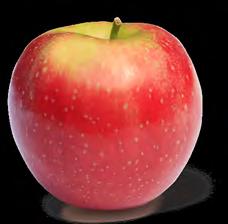
What is your greatest extravagance: My horses. I spend everything on horses and the farm.
Favorite way to relax: Playing poker and hang ing out with family and friends.

Favorite restaurants: La Goutillon in Chantilly, France. SW Steakhouse in Las Vegas, Beach.
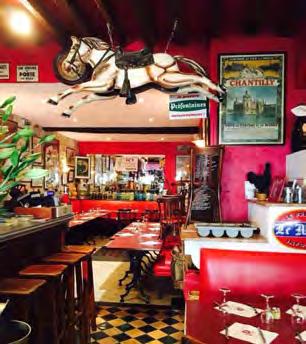


Favorite hotels:
The Encore at Wynn Las Vegas. Amazing resort and the staff is so friendly. We take a trip every year with friends and family.
 COURTESY WYNN HOTELS
LA GOUTILLON
COURTESY WYNN HOTELS
LA GOUTILLON
SW STEAKHOUSE 12 | EQUESTRIAN LIVING | NOVEMBER/DECEMBER | 2022 EQ FAVORITES
COURTESY US EQUESTRIAN TEAM

The Art of Horsemanship • World-class equestrian center • Exceptional equestrian studies program • National championship team Your future is bright at SCAD. To learn more about SCAD equestrian or explore other award-winning programs, visit scad.edu or email admission@scad.edu.
Fabulous Gift Ideas for Equestrians

NIKOVIAN
INVICTUS BREECH
Nikovian’s Invictus breech was designed for style and per formance. The compression technol ogy increases blood flow. Minimized seams prevent painful marks on the calves. A thick, high-waisted, textured waistband keeps shirts tucked in, engages the core, and accentuates curves. Made for all athletes, sizes XS-3X. $195.

Nikovian nikovian.com
OCTOBER DESIGN
LEATHER FRAMED SNAFFLE BIT MIRROR

Finely crafted mirrors, lighting, and home goods, detailed with hand-tacked leather and authentic equestrian hard ware. Or honor your special baby (we mean your horse, of course!) with a custom design using your tack. Shown: 24”x17” mirror with buffalo leather. $725
October Design Equestrian Décor Hudson, New York 347 671-9249 Info@octoberdesign.com octoberdesign.com
ESPOIR EQUESTRIAN
ROPED HORSE ON NAVY
Espoir Equestrian 50 Upf sunshirts look and feel great in or out of the tack. Ladies sizes XS-2X. Experience the new Full Circle Collection at espoirequestrian.com or at a dealer near you. $108.
Espoir Equestrian espoirequestrian.com

14 | EQUESTRIAN LIVING | NOVEMBER/DECEMBER | 2022
EQ HOLIDAY GIFT GUIDE
LISA DAHLEN DESIGNS
ONE-OF-A-KIND ANCIENT COIN JEWELRY
Select
sourced and
fabricated
recycled 18kt gold.
Shown: Ancient Celtic Coin Pendant, early 3rd century BC. $9,585.

VOLTAIRE
VOLTAIRE DESIGN WEEKEND BAG
This travel bag is spacious yet lightweight with a removable strap to carry it on the shoulder or by hand. The Weekend Bag is elegant and waterproof, with zip closure. The perfect gift for any eques trian, the Weekend Bag allows you to carry all your personal belongings wherever you go! $290.

Lisa Dahlen Designs
Los Gatos, California lisadahlen.com lisa@lisadahlen.com
HORSE COOKIES
ORGANIC ALL NATURAL HORSE
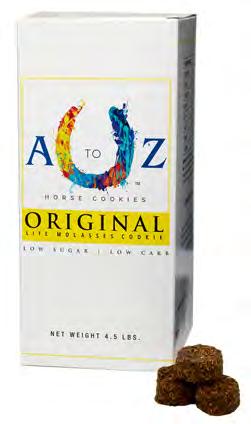

Voltaire Design USA 12509 NW 44th St Coral Springs, Florida 561 569-4048 voltairedesign.com/us
FAIRFAX AND FAVOR
THE ROCKINGHAM ANKLE BOOT, CHOCOLATE

Howdy, cowgirl! Putting a Western twist on our popular Chelsea, the Ankle Rockingham is your new go-to when the dress code says casual. Slung under slouchy mom jeans or paired with a floaty floral number, it’s a sure-fire way to take every outfit from great to greatest ever. Features fine-grain suede outer and fully leather-lined interior with decorative hand-stitched detailing. Leather/rubber composite sole and memory foam insole. These boots are made for walking! $345.
Fairfax and Favor fairfaxandfavor.com
NOVEMBER/DECEMBER | 2022 | EQLIVING.COM | 15
COOKIES A2Z
an exceptional gift for the equestrian in your life. Ancient coin jewelry individually
designed; locally
using
A2Z Horse Cookies atozhorsecookies.com Blonde Bits of HealthOriginal Flavor
4.5 lb container $37.95 2.5 lb container $27.95 EQ HOLIDAY GIFT GUIDE
MARK CROSSSEALY LUX ELITE DOG
QUAD LAYER TECHNOLOGY, ORTHOPEDIC MEMORY FOAM, AND COOLING ENERGY GEL
High-quality therapeutic bed provides support for dogs of all ages and is comfortable for dogs with arthritis, joint, or bone problems.

The removable cover is machine washable, and this lux bed is built with a pro-charcoal base to help absorb odors, keeping your dog bed fresh.
48” long x 32” wide x 8” thick. $182.63
Sealy eqliving.shop/XyO
DICK FRANCIS COLLECTION
10-BOOK SET
On the night tables of equestri ans, Dick Francis’s thrillers are set in England’s horse world. The 10 paperbacks include Hot Money, Dead Cert, Longshot, For Kicks, In the Frame, High Stakes, Banker, Forfeit, Enquiry, Odds $34.99.

Amazon eqliving.shop/gtP
SNAP TRIFOLD WALLET

Imported 100% tumbled calf leather with one Lionhead Snap Button, eight card slots, two slip pockets, and a full-length bill compartment. Several colors available.
4” long x 4” wide x 1” thick. $450.
Mark Cross http://eqliving.shop/Ge9
FURBO DOG CAMERA
360° VIEW WITH ZERO BLIND SPOTS
See more than ever before with the allnew rotating Furbo 360° Dog Camera. Hear and speak to your dog, and toss it treats from anywhere you are. Know what’s happening with realtime Barking Alerts. Full HD video with color night vision. $108.
Furbo eqliving.shop/7pH

16 | EQUESTRIAN LIVING | NOVEMBER/DECEMBER | 2022
BED
EQ HOLIDAY GIFT GUIDE
ROYALTY PORCELAIN
58-PIECE LUXURY GREEK HORSE CHEVAL DINNER SET

This dishwasher-safe premium bone china set includes: 6 cups and 6 saucers, 6 dinner plates, 6 soup plates, 6 dessert plates, 6 salad plates, 6 small serving spoons, 6 small bowls, 1 teapot with cover 1 sugar pot with cover, 1 creamer, 1 salt & pep per, 1 ashtray, 1 large serving bowl, 1 soup tureen with lid, 1 oval serving plate, and 1 large serving spoon. $999.
MASTER NUNO OLIVEIRA
COLLECTOR EDITION WRITINGS
Royalty Porcelain eqliving.shop/Drw
MARK CROSS
ARC LEATHER TOTE

Deceptively simple, the Arc Tote is a new architectural piece designed for casual, stylish, and on-the-go living. Imported 100% calfskin leather with clip closure. Two colors available.
22.05” long x 4.72” wide x 14.57” high. $1850.
For the first time, the collected writings of Master Nuno Oliveira are now made available in English in one volume with an unmatched collection of photographs. This long-awaited beautiful 244-page hardcover is a must for riders and lovers of fine riding and classical equestrian art.

Nuno Oliveira “...took equitation to new heights of lightness, suppleness, and brilliance. His legacy now spans three genera tions. No other Master in living memory has so captured the art and poetry, the heart and soul, of classical equitation.”–Stephanie Millham $110.
Xenophon Press eqliving.shop/niP
AMERICAN EQUESTRIAN DESIGN

BARNS, FARMS, AND STABLES BY BLACKBURN ARCHITECTS
A favorite of Equestrian Living magazine, Blackburn Architects leads the world in the design of equestrian facilities that are beautiful and innovative. This lavishly illustrated monograph is a celebration of the work of this specialist architecture firm, and a beautiful showcase of some of the most jaw-dropping designs of horse stables and barns. $55.
Mark Cross eqliving.shop/IwR
Blackburn eqliving.shop/8uY
NOVEMBER/DECEMBER | 2022 | EQLIVING.COM | 17
EQ HOLIDAY GIFT GUIDE
ARTIST SAM SAVITT
“DROP JUMP” SIGNED LIMITED EDITION
See the Equestrian Living feature on this beloved eques trian artist: https://https://tinyurl.com/samsavitt1 This high-quality reproduction on heavy paper stock of a painting by artist Sam Savitt captures the fast-paced action of riders in a fox hunt taking a drop jump and galloping to the field below. These limited edition prints were signed by the artist 43 years ago yet they remain in perfect condition. 28”x20”. $189 including shipping.

“SUMMERTIME” SIGNED LIMITED EDITION
This high-quality reproduction on heavy paper stock of a painting by famed equestrian artist Sam Savitt depicts a small group of horses standing under a grove of trees. These limited edition prints were signed by the art ist 44 years ago, yet they remain in perfect condition. While only 950 numbered copies were produced, the ones offered today are the much-rarer Artist’s Proofs/ Publisher’s Proofs. 23”x19”. $189 including shipping.

ARTIST LISA CURRY MAIR
ORIGINAL PAINTING, “PENNSYLVANIA BARNYARD”

ORIGINAL PAINTING, “COMING HOME II”
Vermont artist Lisa Curry Mair has over 30 years of experience. Her work can be seen in museums and private homes throughout the U.S. Canada, Europe, and Central America. She has been featured in magazines such as Yankee, Early American Life, Old House Journal, Early Homes, Equestrian Living and on TV on This Old House.
24”x36” Acrylic on heavy canvas. $2,100. (one available)
Lisa Curry Mair
More info at eqliving.com/mair
Three members of the hunt return after a day out riding to hounds. It’s a surreal moment of quiet and camaraderie as they walk home while hounds tag along close behind. Mair’s stylized shapes on the stark white background bring a contemporary slant to a very traditional subject.
43”x33” Acrylic on heavy canvas, framed $2,100. (one available)

18 | EQUESTRIAN LIVING | NOVEMBER/DECEMBER | 2022
EQ ART GALLERY
Sam Savitt Art More info at eqliving.com/savitt


1-888-354-4740 | www.kingbarns.com SETTING THE STANDARD SINCE 1978 Complete design services and fine craftsmanship Custom barns, arenas, garages, and living quarters
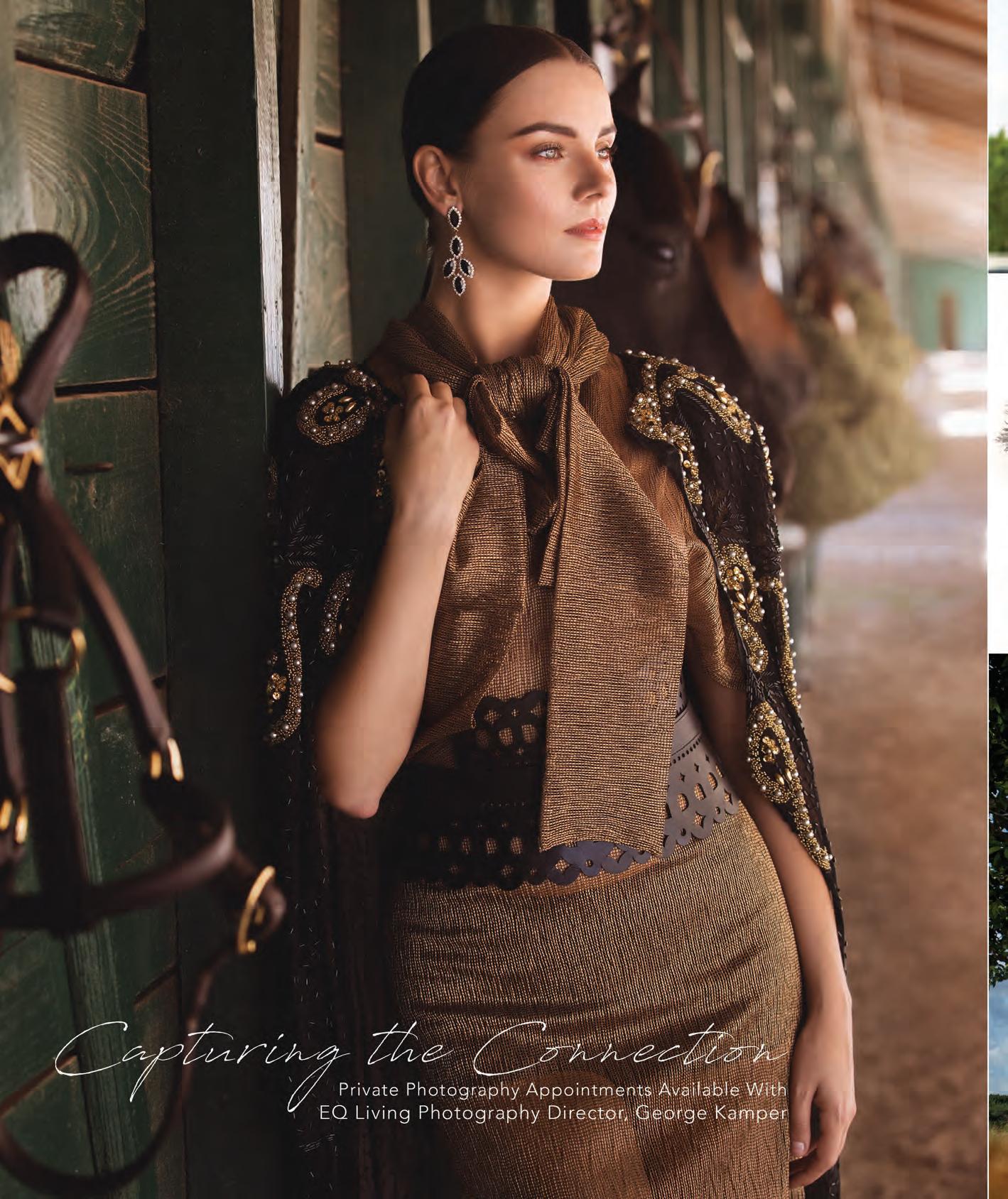

ADD A TOUCH OF FESTIVE FLAIR







ENTERTAIN IN STYLE during the HOLIDAY SEASON with unique, conversation-worthy


Avenue’s
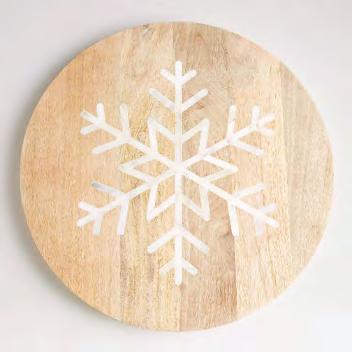
objects. 1. Frontgate’s set-of-six Metallic Ruscus Leaf Stems. $89. 2, 10. Equine Luxuries’ handcrafted set-of-two Cloisonné Fanciful Horse Ornaments. $138. 3. Frontgate’s set-of-six glass, hand-embellished, Sapphire Scroll Ornaments. Two of each style. $79. 4. Jay Strongwater’s three-foot Metal Holiday Tree in hammered brass leaves. At Bergdorf Goodman. $1,500. 5. Terrain’s Antler Mug crafted from new bone china. $24. 6. Vietri’s playful Mistletoe Oval Platter at Saks Fifth Avenue. $79. 7. Crate & Barrel’s Taiga Holiday Snowflake Serving Board in wood with marble snowflake inset. $59.95. 8. Saks Fifth
crystal Olivia Riegle Tree of Life Menorah. $200. 9. LED Pine Cones by Terrain add a little winter magic. Each $28. 22 | EQUESTRIAN LIVING | NOVEMBER/DECEMBER | 2022 EQ D É COR CONTACT INFO | PAGE 92 2 1 3 6 7 8 10 9 4 5


177 East Blithedale Avenue | Mill Valley, California 94941 USA Timeless Luxury for the Sporting Lifestyle stickandball.com
Hermès’ beige, green, and gold La Reale Giant Triangle in cashmere and silk. $810.
LUXE LOOKS
1. The Cashmere Cable Sweater by Callidae in sandstone. $800.

2. Stick & Ball’s Inca Star Poncho in 100% baby alpaca takes inspiration from the Inca culture. $895.


3. Fendi’s Reversible FF wool fringed Poncho in solid color with reversible FF monogram motif. $1,980. (At Bergdorf Goodman.)

4. Two-tone double-face Patch Pocket Jacket by Lafayette 148 in soft cashmere-infused wool with leather buttons. $1,498.

5. Lafayette 148’s Walden Reversible Coat in wool and cashmere. Shown in dark seaweed/kelp combination. $1,398. (At Nordstrom.)

6. Stick & Ball’s luxurious fringed Solid Baby Alpaca Wrap/Throw in rich hues. $255.
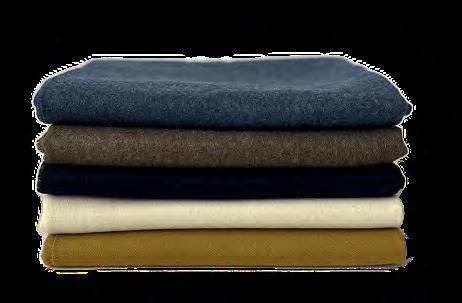
The Double Face Stole in 100% cashmere by Hermès in gray/orange contrasts. $1,225.

Wrap yourself in the casual comfort of CASHMERE AND ALPACA. EQ FASHION 1 2 3 4 5 6
CONTACT INFO | PAGE 92 24 | EQUESTRIAN LIVING | NOVEMBER/DECEMBER | 2022
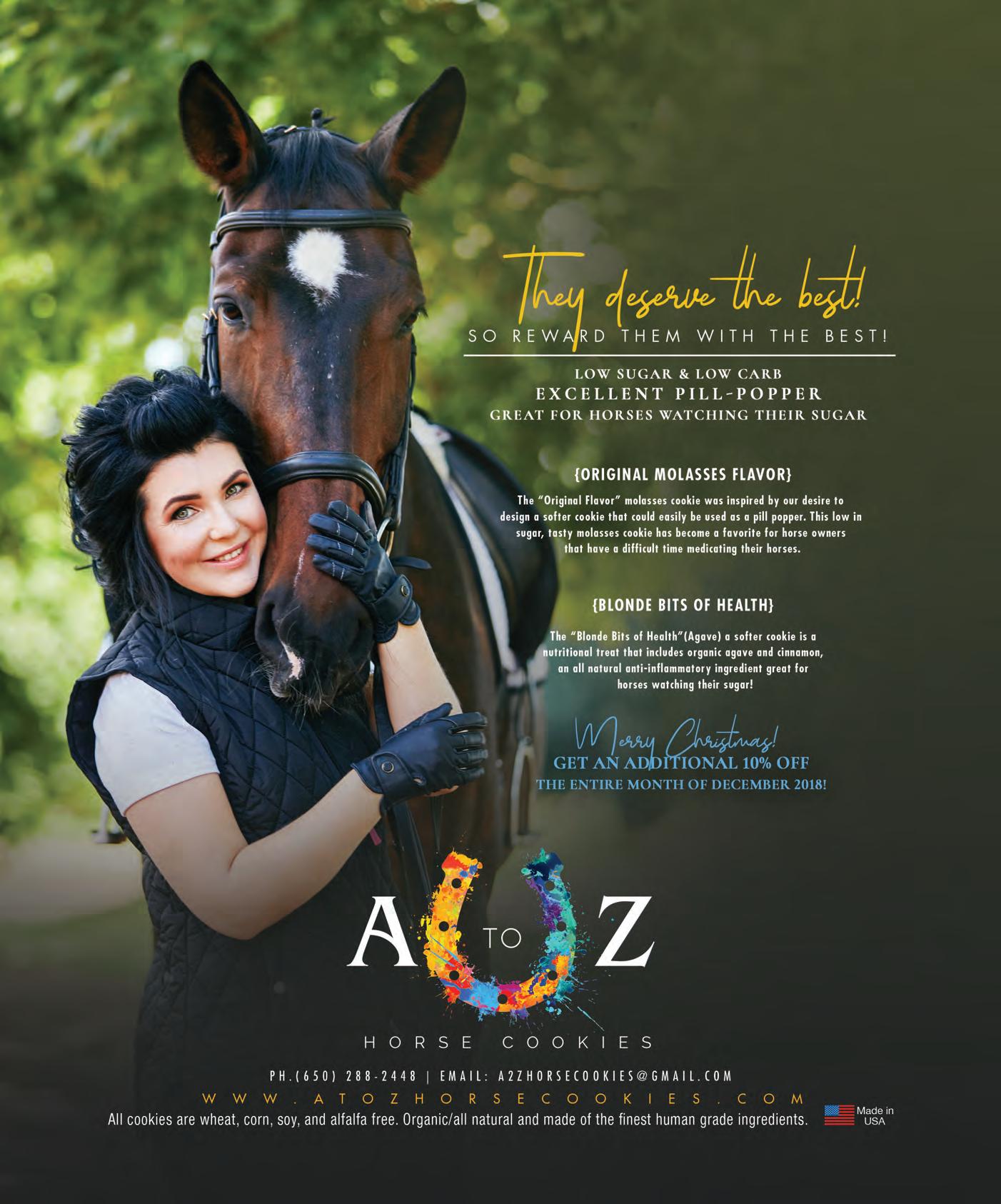

ELEGANT EDIBLES
Executive Pastry Chef of the Prince and the Pauper in Woodstock, Vermont, LIVIA FERRAZ , shares a favorite recipe.
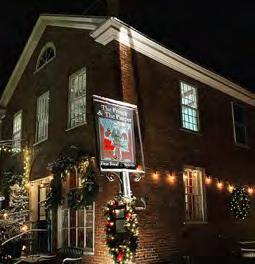

Livia Ferraz Executive Pastry Chef at The Prince and the Pauper Livia Ferraz was born and raised in Rio de Janeiro in a family that would actively cook together, but her culinary career began at one of Brazil’s most prestigious universities, Universidade Anhembi Morumbi for Culinary Arts. A lover of fine din ing, food science, and desserts, Livia found her true passion in pastry. She takes inspiration from the flavors of Brazil combined with the textures and complexity of French pastry. She is dedicated to challenging herself and perfecting her skills and techniques and takes pride in developing her own recipes.
PISTACHIO FINANCIERS
INGREDIENTS (YIELD: 7-10)
100g brown butter
120g egg whites (approximately 4 units)
75g confectioner’s sugar
45g all-purpose flour (For gluten-free, use cornstarch or GF flour)
120g almond flour
100g pistachios
PREPARATION
Prepare mini-muffin pan by brushing butter and sprinkling flour (you may omit flour if using a silicone mold). Heat oven to 375°F.
1. Melt butter in a saucepan over medium heat until golden brown. Strain through a fine-mesh sieve and reserve until cool to room temperature.
2. Add pistachios to a food processor and pulse a few times to break them into smaller pieces (alternatively, you can crush them inside a zip loc using a rolling pin).
3. In a mixing bowl, whisk egg whites and confectioner’s sugar until foamy.
4. Add flour and almond flour and whisk until combined.
5. With the mixer on, drizzle the brown butter, then add the pistachios.
6. Divide batter among the muffin cups or silicone molds, about ¾ of the way (a piping bag makes for an easy filling).
7. Bake it in the middle rack for 16 minutes. Let it cool in the molds/pan, then remove and place to cool on a wire rack.
RUBY RASPBERRY GANACHE
INGREDIENTS (YIELD: 7-10) 180g ruby chocolate (from Callebaut) 150g heavy cream 50g raspberry puree

PREPARATION
1. Combine Ruby chocolate and cream in a bowl over a pot of simmer ing water (water must not touch the bottom of bowl) until chocolate is melted. Whisk until mixture become homogenous.
2. Add the raspberry puree and combine. Let it cool in the refrigerator until fully firm (overnight preferred). Cover with plastic wrap touching the surface so it doesn’t create a layer of skin during the cooling process.
3. Remove from refrigerator and add ganache to a mixer and mix with a paddle attachment to soften.
4. Pipe or spoon the ganache over your Pistachio Financier. Enjoy! Store in refrigerator for 5 days or in the freezer for 3 months.
The Prince & The Pauper restau rant is a Woodstock tradition that has been delighting guests with superb food, creative cocktails, and impeccable service for over 48 years. The menu features dishes from classic to contemporary, cre ated from the freshest ingredients available.
 JESSICA
NOTARGIACOMO
JESSICA
NOTARGIACOMO
LIVIA
FERRAZ
CONTACT INFO | PAGE 92
26 | EQUESTRIAN LIVING | NOVEMBER/DECEMBER | 2022 EQ FOOD+DRINK L O C AL F L A VOR HORSEFAVORITESCOUNTRY

THE EQUESTRIAN LIFESTYLE MARKETPLACE Dallas is home to the American Equestrian Trade Association International Trade Show. The premier global event showcasing equestrian industry products from leading manufacturers across a variety of categories including: APPAREL • TACK • GIFT • HOME • DESIGN LIGHTING • ACCESSORIES • AND MORE!
Ariat
JANUARY 12 -15, 2023 www.dallasmarketcenter.com @dallasmarket Inspiration Starts Here.







MARTHA W. JOLICOEUR, PA BROKER ASSOCIATE 561 797 8040 marthasproperties.com PIERSON ROAD · $18,900,000 Rare Opportunity With Direct Access to Wellington International Showgrounds (Formerly PBIEC) · Newer Build and Meticulously Maintained on 5+ Acres · 24 Stalls With Sand Ring and Grass Field · 6 Large Paddocks and Walker · Owners’ Lounge, 2 Of ces, Tack Room, and Feed Room · 2 Dog Runs · Commercial Laundry · Large Storage Building · 4 Bedroom Apartment: Each Bedroom Has Private Bath and Kitchenette, Plus Shared Full Kitchen, Living Room and Laundry








HOME IS WHERE YOUR HORSE IS THE NEXT MOVE IS YOURS 1111 LINCOLN RD, PH-805, MIAMI BEACH, FL 33139. 305.695.6300 © 2022 DOUGLAS ELLIMAN REAL ESTATE. ALL MATERIAL PRESENTED HEREIN IS INTENDED FOR INFORMATION PURPOSES ONLY. WHILE, THIS INFORMATION IS BELIEVED TO BE CORRECT, IT IS REPRESENTED SUBJECT TO ERRORS, OMISSIONS, CHANGES OR WITHDRAWAL WITHOUT NOTICE. ALL PROPERTY INFORMATION, INCLUDING, BUT NOT LIMITED TO SQUARE FOOTAGE, ROOM COUNT, NUMBER OF BEDROOMS AND THE SCHOOL DISTRICT IN PROPERTY LISTINGS SHOULD BE VERIFIED BY YOUR OWN ATTORNEY, ARCHITECT OR ZONING EXPERT. IF YOUR PROPERTY IS CURRENTLY LISTED WITH ANOTHER REAL ESTATE BROKER, PLEASE DISREGARD THIS OFFER. IT IS NOT OUR INTENTION TO SOLICIT THE OFFERINGS OF OTHER REAL ESTATE BROKERS. WE COOPERATE WITH THEM FULLY. EQUAL HOUSING OPPORTUNITY. PALM BEACH POLO · $4,450,000 Located Within the Exclusive Bridle Path Neighborhood · Stunning Golf Course and Lake Views · 4 Bedroom, 6.5 Bath Estate Home Totaling Over 8,000 Square Feet · 3 Car Garage · Beautifully Designed Pool · Tray Ceiling in Living and Dining Rooms · Oak Paneled Study With Fireplace · Spacious Master Suite · His and Her Baths and Closets · Add Your Personal Touches and Create a Masterpiece! WELLINGTON, FLORIDA WELLINGTON EQUESTRIAN CLUB · $2,475,000 Fabulous Water and Sunset Views · 6 Bedrooms, 6.5 Baths · Impact Glass · Custom Closets and Oversized Laundry Room · 5 Car Garage · 3-Way Split Floor Plan · Salt Water Pool With Marble Pool Deck · 2 Guest Suites, 1 With Separate Entrance · Adjacent to New National Polo Center · Completely Updated · Pristine Condition PRICEREDUCED JUSTLISTED
ARRIVE LOOKING POLISHED
Boot designers skillfully merge fit, performance, and comfort SIX IMPECCABLE STYLES.
Tucci Sofia tall leather dress boot pairs elegant Italian design with high functionality. The Sofia features an extra strong zipper, durability, and comfort in an impeccable made-to-measure fit. Price upon request.
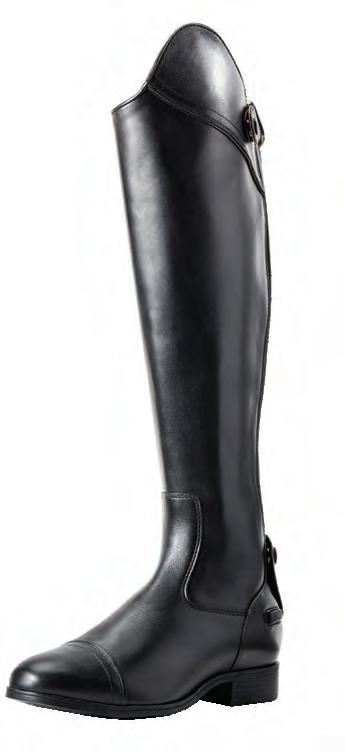



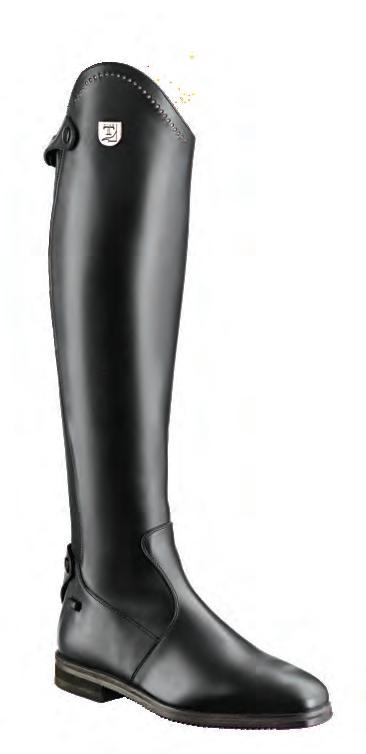
Parlanti Denver Essential calfskin leather dress boot offers a perfect option for the show and training ring. Features include a soft and supple canvas lining, durable zipper, and single-stitch pattern. $650.
Ariat Heritage Contour II field zip tall boot in sienna is crafted in premium leathers with full-length zipper, elasticized laces, and brass logo. Advanced technological features incorporate superior performance and lasting comfort. $359.95.
Vogel Dressage Gramercy boot, designed for the competi tive rider, offers luxury, comfort, and elegance. Technical attributes and high-performance leathers elevate the traditional dressage look with modern appeal. Price upon request.

Vogel’s Madison impeccably styled premier boot boasts a perfect fit and unmatched wearability. Superior balance and support merge perfor mance with modern design, bringing sophisticated style to show jumping and hack ing. Price upon request.
Ariat Kinsley tall dress riding boot handcrafted in premium leather boasts an elegant high Spanish cut topline, full-length zipper, built-in heel cushion, and traction zones for security. $449.95.
30 | EQUESTRIAN LIVING | NOVEMBER/DECEMBER | 2022 EQ FASHION CONTACT INFO | PAGE 92 1 2 3 4 5 6


 This event is designed in partnership with the Bluebird Cultural Initiative to celebrate the traditions and powerful history of the great horse tribes of the plains and honour their invaluable cultural heritage.
This event is designed in partnership with the Bluebird Cultural Initiative to celebrate the traditions and powerful history of the great horse tribes of the plains and honour their invaluable cultural heritage.
NEED A COVERED ARENA?
WELLINGTON, FLORIDA


One of a kind equestrian estate on 5.54 acres with covered & outdoor riding arenas and 17 stall center-aisle barn. Situated in a prime location close to GDF & WEF, this property was designed for top equestrians. The 4Br main residence boasts: stone floors, a center-island kitchen with gas cooking, wine cooler, walk-in pantry, impact window & doors, a stunning heated pool with lap lane, summer kitchen & outdoor gas fireplace. There is also a 1Br/1Bth guest house for family or staff. The impeccable stable features rubber pavers, feed, tack & laundry rooms, cross-aisle and portico walkway to the covered arena. Both arenas have ebb and flow watering systems with world class footing. Offered at $11,950,000



©2022 Engel & Völkers. All rights reserved. Each brokerage independently owned and operated. Engel & Völkers and its independent License Partners are Equal Opportunity Employers and fully support the principles of the Fair Housing Act.
Matt Johnson
Engel &
Volkers
Florida Selling
Wellington
& the Palm Beaches 561-313-4367 • MattSells.com
MATTSELLS.COM
RIDE & ENTERTAIN IN STYLE
WELLINGTON, FLORIDA

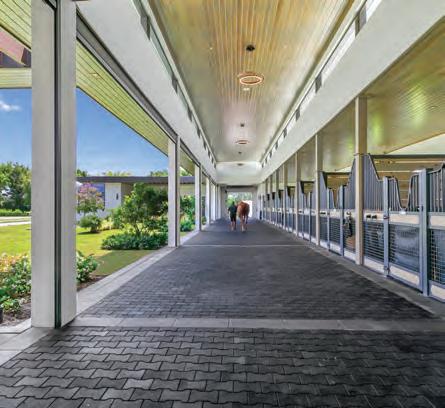

This awe-inspiring 5.24 acre property brings a breath of fresh air to equestrian architecture & design! Offered furnished, the home boasts open concept living with expansive walls of glass & views to outdoor spaces. The center-island kitchen offers Porcelanosa cabinets, quartz countertops, gas cooking, double ovens & large walk-in pantry with extra refrigeration. The master-suite showcases a luxurious dressing room & bath w/ a double sided gas fire feature, digital shower & soaking tub. Entertain poolside at the summer kitchen or on the 2nd story sundeck bar watching sunsets over the polo fields. Riders will love the 8 stall courtyard stable with stunning tack room & viewing lounges, jumping arena, exercise track, hotwalker, treadmill & more. The adjacent 10.48 acres is also for sale. Offered at $11,000,000

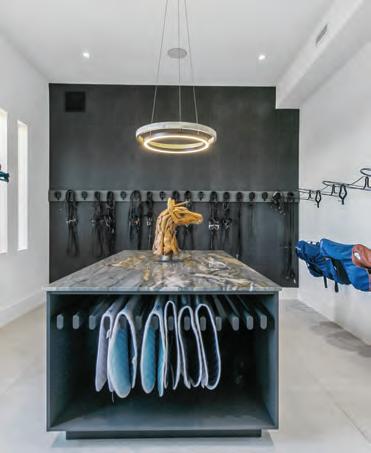
©2022 Engel & Völkers. All rights reserved. Each brokerage independently owned and operated. Engel & Völkers and its independent License Partners are Equal Opportunity Employers and fully support the principles of the Fair Housing Act.
Matt Johnson Engel & Volkers Florida Selling Wellington
& the Palm Beaches 561-313-4367 • MattSells.com
MATTSELLS.COM Reduced
BEST YOGA PRACTICE FOR EQUESTRIANS

Yin yoga expert KASSANDRA REINHARDT discusses yoga, horses, and her new book.
How did you find yoga, and when did it become a focus for you?
Igrew up dancing ballet, and at 18 years old I decided to try my first yoga class in an effort to increase my strength, flexibility, and balance. I loved dancing, but it was very hard on my body, so I ended up transitioning away from dance and into yoga. I loved how yoga empha sized the way you felt versus the way you looked. It allowed me to lower the very high expectations I placed on myself and to truly care for myself in a deeper way.
What was your first connection with horses? What kind of riding do you do now?
I was around horses from a very young age, but unfortunately, the only riding I got to do was at a few summer camps and a trail ride here and there. Riding was simply too expensive and inacces sible in my area, but I always hoped that one day I would be able to afford it and really dive in. At 30 years old, I moved to the country and was finally able to fulfill my lifelong dream of riding. I was hooked from the start and took as many lessons as I possibly could at a wonderful barn nearby, the Maplewood Equestrian Centre. I ride English, so I do a little bit of dressage and jumping. With my coach’s blessing and assistance, I eventu ally began the search for my own horse. Riding is really fun, but I’m also focused on horsemanship in general and spend a lot of time doing groundwork, posi tive reinforcement training, and learning about equine behavior.
Can you tell me about Java and how you met him?
Java is an 8-year-old Percheron and Quarter Horse bay gelding, standing 16 hands. I purchased him in January of 2022 and have spent this year getting to know him on the ground and under saddle. He has a very big and strong personality, but he can also be incred ibly sweet and tries so hard. He’s a great match for me because he’s very tolerant of the many mistakes I make as a beginner while also being a horse I can grow with for years to come. I love him very much, and my daily barn visits to see him are the highlight of my day.
What were your career/life plans like originally? Was this career path what you expected it to be?
I certainly never imagined I’d be a pro fessional YouTuber! When I started my YouTube yoga channel, I was a full-time
municipal government employee. I just thought YouTube would be something I could do for fun, not realizing that even tually, it would span into a full online marketing and e-commerce business.
I never could’ve planned for this and certainly never thought I’d be a twicepublished author!
What do you see as the most valuable reasons to practice yoga?
Yoga is all about perspective and going beyond the ego. It’s a wonderful way to remind yourself of the bigger picture and the interconnectedness of all beings. I practice yoga because it is good for my physical, mental, emotional, and spiritual health.
What, in particular, are the benefits of yoga for equestrians?
Yoga can help equestrians both in and out of the saddle. Even the simplest yoga practice can help you increase flexibility in your hips and ankles, strengthen your core and thighs, and improve your pos ture to make you a more balanced rider. I also like to practice yoga after my rides to stretch out sore muscles and release ten sion from my body. Another key element of yoga comes from pranayama, or breath ing techniques, that teach you to use your breath as a way to control your mental and emotional state. Our breath regulates our nervous system, and as we all know, horses are very attuned to how we feel. For better or worse, horses feed off our energy. Yoga teaches us how to control it. Some simple poses that equestrians can start practic ing to improve their riding include child’s pose, downward dog, low lunge, dancer’s pose, plank, and saddle pose.
CONTACT INFO | PAGE 92 34 | EQUESTRIAN LIVING | NOVEMBER/DECEMBER | 2022 EQ PEOPLE
Kassandra Reinhardt is the founder of Yoga with Kassandra, a YouTube community of over 2 million known for bite-sized 10-minute daily routines. She recently published her second book, Year of Yoga: Rituals for Every Day and Every Season.
INTERVIEW BY JILL NOVOTNY
OBJECTS OF DESIRE
RALPH LAUREN
Long associated with the equestrian lifestyle, Polo Ralph Lauren has introduced the Polo ID Collection, which embraces a spirit of adven ture and optimism. Inspired by the untamed beauty of wild horses and equestrian craftsmanship, the col lection in rich Italian leather includes handbags, small leather goods, and footwear. The namesake brass hardware thread throughout the line highlights the iconic pony player logo, which nods to keepsake family heirlooms.


HERM È S
The brand’s long-standing equestrian heritage dating back to 1837, puts Hermès at the pinnacle of incorpo rating the equestrian tradition into the heart of their timeless objects. The house is committed to preserv ing its excellence and celebrating its rich past in the equine world throughout its objects, whether their impeccably handcrafted sad dles, handbags, or signature scarves.

At left: The Concours d’ Etriers wash scarf in silk twill with handrolled edges showcases a variety of stirrups. The 36-inch square is shown in the black, beige, and multi color combination. $495.

LONGINES

Polo ID CrocEmbossed Envelope Chain bag merges the structural elegance of an envelope with a versatile chain linkand-leather strap. $598.
Referencing the equestrian world synonymous with Longines, the design of the new DolceVita X YVY watch has paired its famous rectangular timepiece with Zurich’s YVY’s double-leather straps. “We wanted to develop a new approach together to the world of horses and their bridles,” explains Yvonne Reichmuth, founder of YVY.
Below: the Longines DolceVitaX YVY quartz watch with silver “flingué” dial. The second thin strap can be worn on its own. Shown in brown. $1,600.
The INCOMPARABLE STYLE
of three brands steeped in a rich
EQUESTRIAN HERITAGE
Polo ID Calfskin Saddle bag with dual-adjustable straps and finished with a magnetic slide lock. $698.
Polo ID Calfskin Shoulder bag with dual-compartment silhouette, suede interior, brass pony cut out on gold-tone brass. $798.
NOVEMBER/DECEMBER | 2022 | EQLIVING.COM | 35 EQ STYLE CONTACT INFO | PAGE 92
THE ART IN THE ART
An excerpt from FOR THE LOVE OF THE HORSE by Mark Rashid.
Years ago, I bought a seventeen-yearold ranch horse by the name of Mouse. Mouse had endured many years of unfortunate handling that caused him to be pretty troubled around humans in general and strangers in particular. He was worried about being caught, he didn’t like to be saddled or tied or groomed or ridden. He didn’t like people touching him or approaching him or moving around him in almost any way.
In fact, the list of things he didn’t like was much longer than the list of things he did. Even so, and to his credit, he would always try to do what was asked even though it would trouble him, most likely because he learned over the years that those things were just part of his job. He just didn’t like any of it much.
I got him from a friend who bought him a year or so before as a horse to practice his roping with. My friend, by his own admission, didn’t try to do much to help him with any of his troubles. By the same token, he hadn’t made any of them worse, either. I saw him ride Mouse on several occasions and watched firsthand the kind of worry the gelding packed around. But still, there was just something about him that resonated with me, and when my friend decided to move on to a little more refined roping horse, I bought Mouse from him.
This excerpt from For the Love of the Horse by Mark Rashid is reprinted with per mission from Trafalgar Square Books.


Having just retired my good saddle horse Buck from travel ing, Mouse hit the road as my primary clinic horse. I realized almost from the start that the last thing Mouse needed was more training. You know, the kind of training some folks feel the need to use to help a troubled horse feel better. Mouse had plenty of training and more than enough handling in his life. What he hadn’t been given much of was time to learn how to be okay when he was around people, and particularly when someone was on his back. Luckily for me, time was some thing I had plenty of.
Don’t get me wrong here. I am in no way suggesting working with horses to help them feel better when they’re worried or troubled is a bad thing. When done properly, it can be an extremely effective way of getting horses to understand and ultimately be okay with the tasks they’ll need to know to perform their jobs. But as I said, in Mouse’s case, more training didn’t really seem like the best course of action.
Instead, I made the decision early on that I would simply work with and ride him the way I wanted him to go. What that meant for the two of us was I wouldn’t necessarily ignore the things that bothered him or behavior he offered up that I wasn’t look ing for, but by the same token, I wouldn’t really put much energy into those things either. In other
“It takes great courage to pick up a sword, it takes even greater courage not to use it.” –Author Unknown
36 | EQUESTRIAN LIVING | NOVEMBER/DECEMBER | 2022 EQ FAVORITES E Q B O K C LUB BETWEEN THE COVERS Continued on page 38
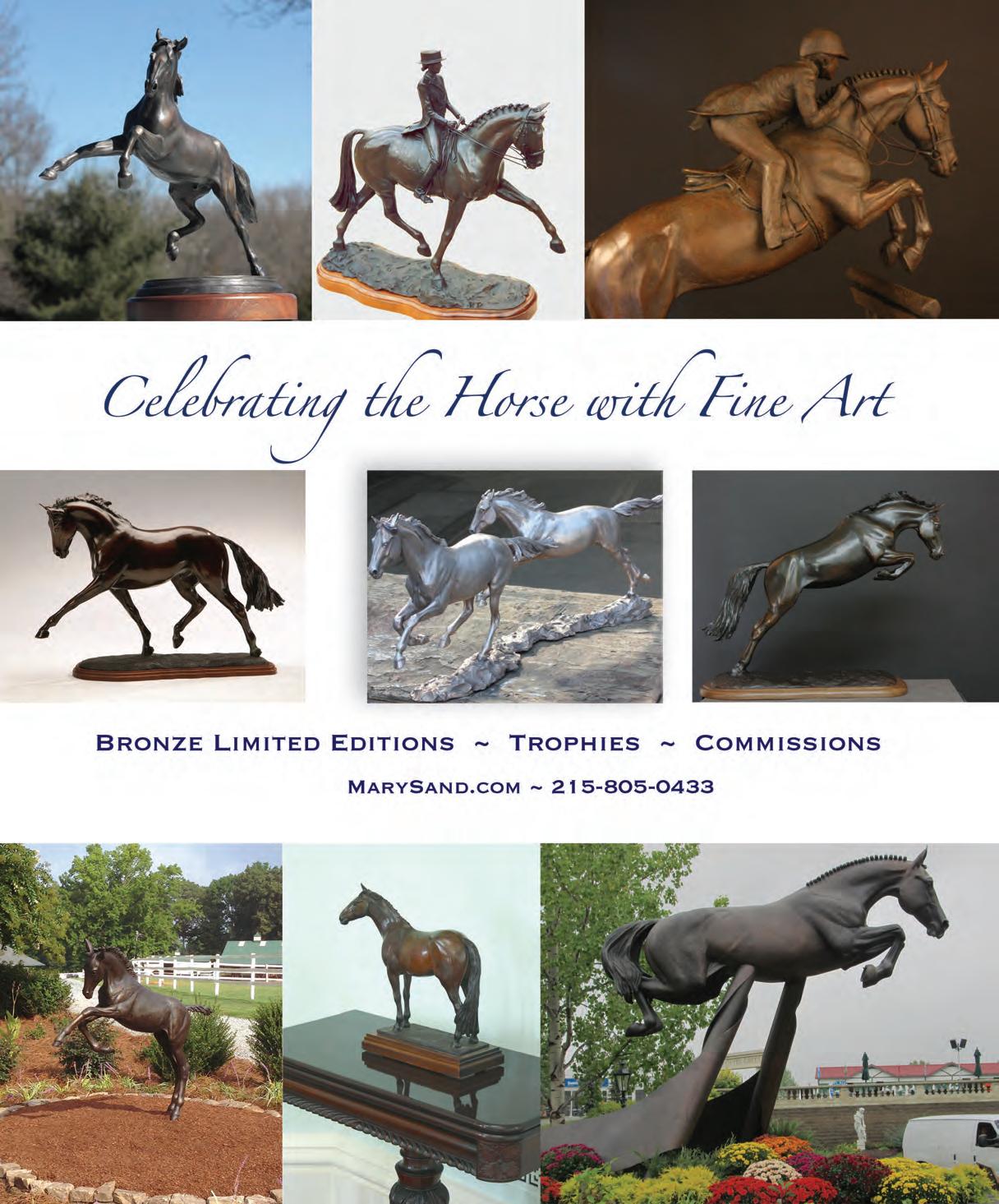
words, I didn’t make a big deal out of anything he offered that I didn’t want. Instead, I mostly just redirected the things I didn’t want as a way to turn them into the things I did. This took on a variety of dif ferent looks, depending on the situation and the behavior he exhibited, but ultimately, the end goal was always the same. I wanted him to see I could be depended upon to help and guide him when he was trou bled, instead of putting more pressure on him by trying to train the trouble out of him.
I think sometimes as horse people we have been so inun dated with information on how to fix this problem or that problem that we think we have no other recourse but to attack any problem we come across head on, using any number of techniques or tools at our disposal. Then, if these things fail, or possibly even make the behavior worse, we simply go through the same protocol all over again, usually with the same unfortunate results. I sup pose it’s part of the human condition: when something doesn’t work, we want to fix it. If horses are troubled, we want to help them feel better. Of course, we are genuinely concerned about the horses, and we really do want them to feel better. But in some cases, we want them to feel better because their behavior is a direct reflection on us as horse people or trainers. If they aren’t acting a certain way, then it somehow shows holes in our horse training/handling education, and we can’t have that.
Looking at it perhaps another way, there is an interesting phenomenon a lot of martial artists go through when they first begin their training (particularly those who begin their training

as adults). Usually after a month or two, new students begin to learn the basics of their chosen art. By this time, they have learned a few sim ple techniques like punches, grabs, kicks, or whatever, and because of this, some of these students begin to feel a sense of power in their newfound, although fledgling abilities.
What happens next is the interesting part. Many of these students, most of them peace-loving average people who never even considered getting into a scuffle with anybody before, suddenly begin to imagine sometimes elaborate self-defense scenar ios. They may see themselves as the hero in a would-be mugging, or breaking up an attack from a bully out on the street somewhere, or any number of other scenarios in which they are able to use their newfound skills.
What is really happening is these students are learning a new skill, and they want to put it to use in some way—in any way. In fact, many are the new martial arts students who have only been training a short time and go out looking for a fight, only to have their hats handed to them by someone faster, bigger, and with more skills or talent.
I think, sometimes, as horse people, we are in the same boat. We go to this clinic or that one, learn a few skills, pick up a few new techniques, buy a flag or a rope or any number of other training tools, then suddenly feel the need to go out and find a situation in which to use them. Sometimes the situation is the right one, and we are able to make some significant progress and headway in helping a horse. Other times, the horse may
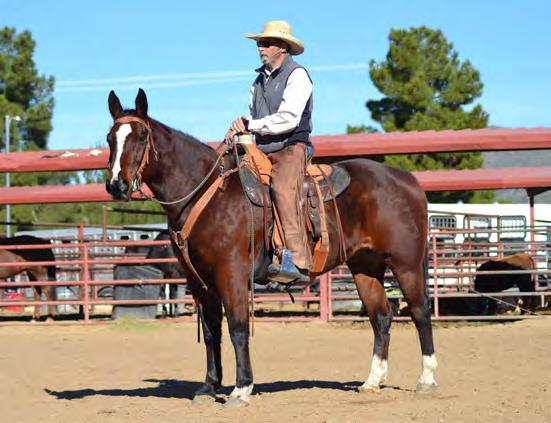

38 | EQUESTRIAN LIVING | NOVEMBER/DECEMBER | 2022 EQ FAVORITES Continued from page 36 THE ART IN THE ART E Q B O K C LUB BETWEEN THE COVERS
ALEXIS KLETJIAN
appear to be complying, but isn’t terribly willing, and still other times we have our hats handed to us by a horse that isn’t buy ing into what we have to offer because what we are offering isn’t what he needs. If we’re lucky, one day we learn the difference. If we don’t, we will simply go along day after day, year after year, repeatedly making the same mistakes.






Not long ago an aikido master with forty years of experience was teaching a class I attended. At one point, he mentioned he learned almost all the technique he would ever need during the first ten years of his training. He then said he spent the next thirty years trying to figure out how not to use it.

It was a profound statement for me in both my martial arts training, as well as in my work with horses. Just because we might be good in martial arts doesn’t mean that every argu ment we have with someone has to end with us punching them in the face. And just because we might be good at training horses doesn’t mean that every horse we come across with some kind of issue needs us to train the prob lem out of them.
LEARN HOW EQLIVING CAN HELP: JOYCE
If there is one thing Mouse, and countless others like him, have taught me over the years, it’s that the art in any art is in knowing when the skills we’ve worked so hard at refining are needed, and when they aren’t. Of course, in the end, this is arguably the most difficult skill of all to develop, which in turn, also makes it the most valuable.
INFO | PAGE 92
NOVEMBER/DECEMBER | 2022 | EQLIVING.COM | 39 EQ FAVORITES
REINING BY THE BAY


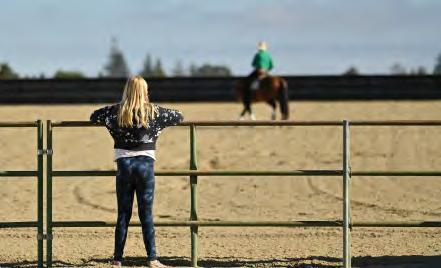
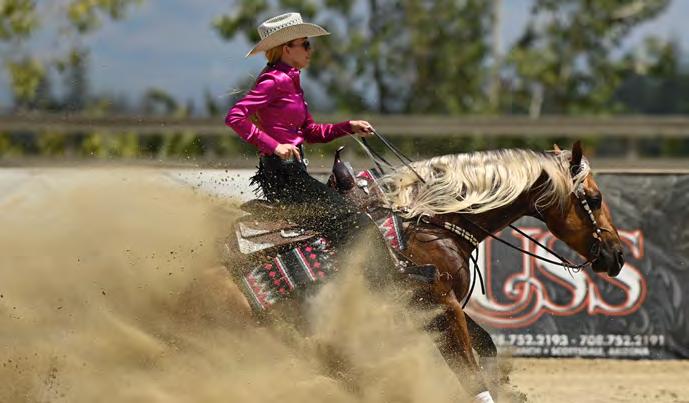

1 2 5 8 9
Photographer ALDEN CORRIGAN captured Reining by the Bay at the Horse Park in Woodside, California, for Equestrian Living. The show has evolved since its founding in 1999 into an incredible event that attracts participants and spectators from all over the country. The beautiful sur roundings and amazing climate of the San Francisco peninsula makes it an ideal location to hold such a prestigious event. 40 | EQUESTRIAN LIVING | NOVEMBER/DECEMBER | 2022 1. The mane event. 2. 91-year-old William Shatner (aka Captain Kirk from Star Trek) and William Shatner and Cee My Smokin Pistol. 3. Non Pro Derby L3 Champion Joes Genes & Tish Fappani mark a career best 222.5. 4. Chuy Chavez and Post Palone. 5. EPaige Pastorino and Tylor Made Magnum. 6. Open Derby L4 Champion and NRHA World #1 ranked rider Andrea Fappani and All Betts Are Off. 7. Open Derby L3 Champion Matt Mills and Stopping in Jersey. 8. Where it all begins. 9. Chandler Winard and Whoz Joe Daddy. 10. Reserve Champion Open Derby L4 Andrea Fappani and Starjac Vintage 11. Brogan Marie Hill and Quik Draw Mcgraw. 12. Best babysitter.


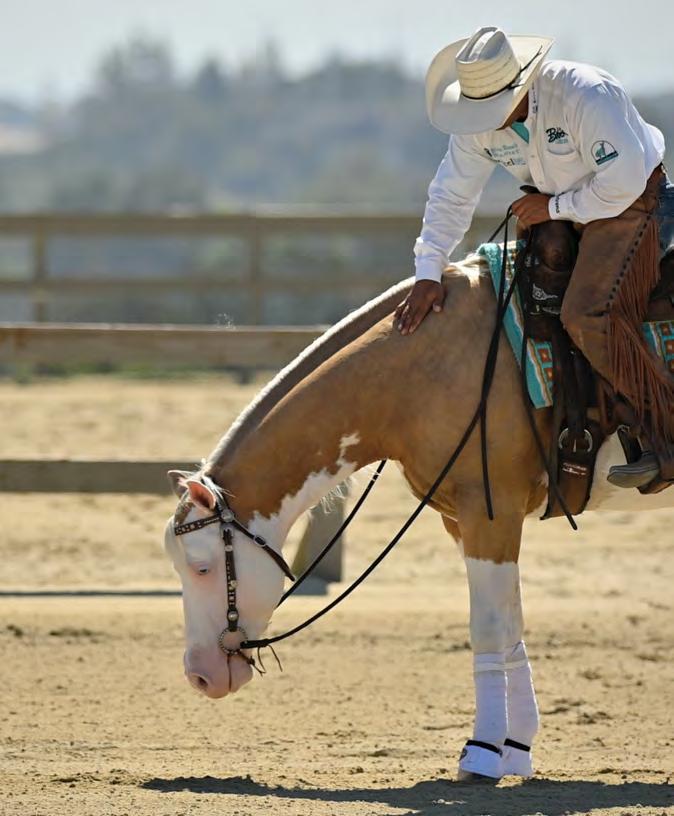
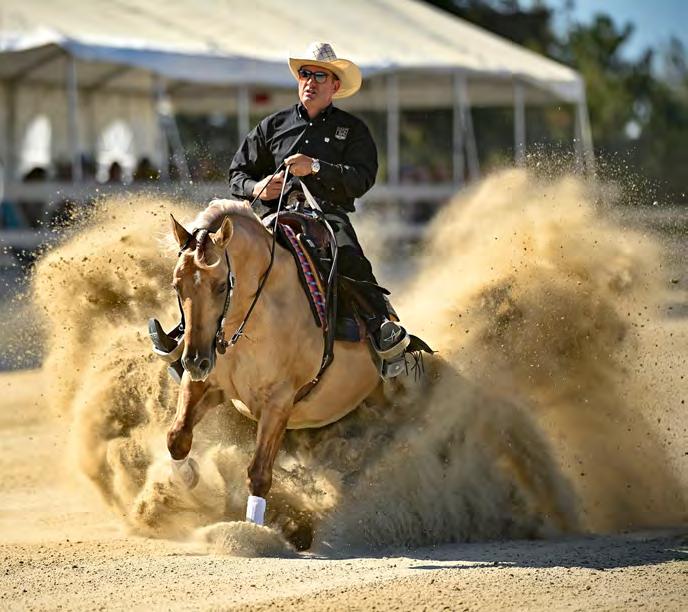
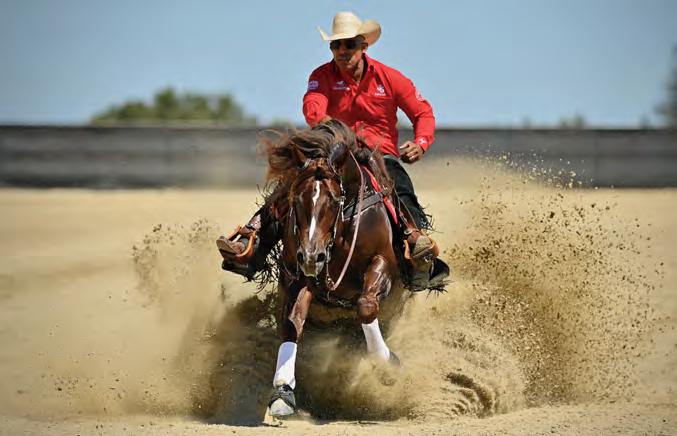


3 4 7 10 11 12 6 NOVEMBER/DECEMBER | 2022 | EQLIVING.COM | 41
A FIRST TASTE OF ALBANIA
A PERSONAL TRAVEL diary IRIS OF EQUUS JOURNEYS


OUR STORY STARTS IN Gjirokastra. This small medieval city located in the south of Albania, roughly a four-hour drive from the country’s only airport, is also a UNESCO world heritage site. It’s perched on the side of a moun tain, dominated by an imposing fortress.
We enjoy exploring the town’s wind ing streets and bazaar before meeting our group at the hotel, seven of us, com ing from across the world. Dinner is our chance to get acquainted and to meet our guides, owners of one of the only two equestrian centers in the country.
They ask us about our riding prefer ences before giving us the names of our horses. Socrates is a philosopher at heart. Propus has a lovely, round canter. I’m given Hektor and told he’s as brave as the Greek hero. My guide also says he is a very “serious” horse. I’m a bit puzzled by this, but suppose it is for me to find out. (Will he wear glasses and a mustache? Does he stay home on a Friday night?)
The skies are blue as we arrive at the stables the following morning. The
horses are lined up and waiting for us. I meet my serious horse—he looks at me and tolerates a cuddle. And just like that, we are off on an adventure.
Our first impression as European and North American riders: are we really going to canter along that steep, narrow, stony path? Yes, we are. And guess what? It’s all fine. My horse is like nothing I’ve ever ridden. He’s energetic, quick, and so sure-footed. I soon realize that every horse in our group is the same.
They are all from a local breed that was slowly disappearing before the team started a conservation program. They are small and strong: we are told it’s a cross between Tarpans and Arabians brought
over by the Ottomans. After a week of scrambling up and down the mountains, I’d be willing to bet there is a mountain goat streak in there somewhere too.
Hektor is fearless and loves his job. Sometimes his enthusiasm goes a little bit over the top; his name marks him as brave and a fighter, after all, but I know I can trust him to carry me safely across moun tains, over rivers, and into deep valleys.
All the horses are shod in a way I’ve never seen before: a full plate with a curved spike over the heel, held in place by three nails on each side. It is unusual, but it does a great job of keeping the stones out, which proves quite useful.
Most of the trail takes us over the ancient pathways built by Ali Pasha so that caravans of Ottoman merchants could drive their wares from village to village. Under the small hooves of our horses, we distinguish old roadways and loose pavement stones, an impressive feat of construction sadly left to fall into ruins for lack of a conservation
42 | EQUESTRIAN LIVING | NOVEMBER/DECEMBER | 2022 EQ TRAVELEQ TRAVEL
MELISSA
JONES
PHOTOS: EQUUS JOURNEYS
budget. The same is happening to the Byzantine and Paleo-Christian churches we see throughout the week. Although the locals make some effort to preserve the stunning heritage, there is more to be done, hopefully before time and rivers wash it away.


Every day and night, one of us goes out to check and feed the horses. One of the features of this trail ride is that we are responsible for the horses at night; it’s an adventure, not a relaxing holiday. At 8:30 a.m., we are usually on horseback, ready for four to six hours in the saddle. Lunches are simple picnics: eggs, tomatoes, byrek (filo pastry pies, normally stuffed with spinach and cheese), olives, bread, and feta


cheese. We eat sitting on the ground by a river, on makeshift stone tables by an old mill, at a table near a shepherd’s hut.
We spend the evenings with local families that welcome us into their homes with open arms and enough food to feed three times our group. Many don’t speak much or any English. We learn the basics, which is all we really need. (One word to remember: Gëzuar, cheers.) We puzzled the pieces of their stories together with a bit of sign language, a little French, Russian, and Italian, and a few old photo
albums. They are not always joyful. You have to remember that Albania was a dic tatorship and a communist state until the implosion of the USSR in 1991. In many ways, the country still bears the scars of that time.
We stayed with people whose sto ries touched us. We learned traditional dances in front of an abandoned school in a village where there were no more children. We shared cups of tea while looking at old family pictures and hear ing about the sacrifices a young man made to be with the woman he loved. We all made memories that will stay with us for a long time, well beyond the riding experience.
NOVEMBER/DECEMBER | 2022 | EQLIVING.COM | 43 EQ TRAVELEQ TRAVEL
PAGE 92
SERIES
Featuring dogs rescued by DANNY AND RON’S RESCUE, the Life in the Doghouse chapter books for children are both inspiring and fun.



Danny Robertshaw and Ron Danta are horse trainers and ani mal lovers who began to rescue dogs during Hurricane Katrina in 2005, when they saved over 600 dogs. Since then, Danny and Ron have taken dogs into their personal home in South Carolina and formed a nonprofit 501(c)(3) called Danny and Ron’s Rescue that has saved and rehomed tens of
thousands of dogs, often to homes within the equestrian industry.
The pair and their organization were the subject of Netflix’s award-winning documentary Life in the Doghouse, which has skyrocketed their popularity even further, including to those outside of the equestrian world. Together with author Crystal Velasquez and illustrator Laura Catrinella, they have written a series of chapter books for children, inspired by real dogs from their rescue.
The first book in the series follows an old dachshund named Elmer who wants nothing more than to find a forever family, but his floppy tongue never fits the families’ idea of the perfect pet. When Benny moves to town, and his family adopts Elmer, he isn’t thrilled. But they find out that the perfect best friend might be different than they imagined, and even better than they might have hoped.
The second book features a hardto-train little puppy named Moose, adopted by a girl named Rosa who needs a topic for her science proj ect. Her idea might just solve both her problems in science class and her troubles training Moose.
Book three is about Millie and Daisy, two bonded dogs who find safety at Danny and Ron’s Rescue. Millie is settling in eas ily, while Daisy is feeling anxious about everything. She’s not so sure about getting adopted, but she also doesn’t want to spoil anything for Millie, or to be separated from her. How will they find the right solu tion for both of them? Will finding their forever home mean saying goodbye to each other?
The fourth book in the series fea tures Finn, a Redbone hound with three legs who finds out that his new home has a cat sibling that also has three legs. Finn is sure they will be best friends, but Rusty has other plans. The two vie for attention as the family prepares to welcome a new baby. Will the two find a way to get along before their new human sibling arrives?

A FEEL-GOOD
CONTACT INFO | PAGE 92 44 | EQUESTRIAN LIVING | NOVEMBER/DECEMBER | 2022 EQ FAVORITES 1 2
3 4

www.EquilineAmerica.com 3460 Fairlane Farms Rd. Ste 15. Wellington, FL 33414 27 Olcott Square Ste B. Bernardsville, NJ 07924




8 - BEDROOMS | 12.3 - BATHS | $23,500,00014775 Equestrian Way WELLINGTON, FLORIDA | 7.3 ACRE EQUESTRIAN PROPERTY David Welles P.A. 561.313.9123 dwelles@equestriansir.com wellesproperties.com With the nicest barn in Wellington, La Victoria Farm, a 7.3 acre equestrian property has it all! Located only a short hack to the show grounds this 28 stall equestrian property with main residence is designed for the ultimate equestrian life style. Custom built with no expense spared using only the finest materials.



WE LL INGTON BROKERAGE 1 2180 SOUTH SHORE BLVD. SUITE 102, WELLINGTON FLORIDA, 33414 | 561.771.2626 | INFO@EQUESTRIANSIR.COM Sotheby’s International Realty® and the Sotheby’s International Realty Logo are service marks licensed to Sotheby’s International Realty Affiliates LLC and used with permission. Equestrian Sotheby’s International Realty fully supports the principles of the Fair Housing Act and the Equal Opportunity Act. Each franchise is independently owned and operat ed. Any services or products provided by independently owned and operated franchisees are not provided by, affiliated with or related to Sotheby’s International Realty Affiliates LLC nor any of its affiliated companies. The information contained herein is deemed accurate but not guaranteed. Pricing subject to change without notice.. All rights reserved. All copywriting and photography are property of Equestrian Sotheby’s International Realty. Reproduction and distribution without written permission are prohibited. PRESENTED BY David Welles LOXAHATCHEE GROVES, FLORIDA | AP HACIENDA- 20 ACRE EQUESTRIAN COMPOUND 4 - BEDROOMS | 4.2 - BATHS | $8,950,0002444 B Road One of the most architecturally significant equestrian properties in Palm Beach County located only a short drive to all equestrian venues in Wellington. This 37 stall property with 16 irrigated paddocks with water, 72’ round pen, 3 acre Bermuda grass jump field, perimeter exercise track, and 2 separate gated entrances,
A NEW WAY TO BET ON THE PONIES
SHOW-JUMPING DATA builds a new FANTASY SPORT.

As Clementine Goutal was finishing her MBA at Columbia Business School, she received a tantalizing phone call from Olympic show-jumper Lucy Davis. “She called to tell me that she was start ing Prixview with Rob Gierkink.”
The founder and chairman of Datalogix, Rob has a long career in data analytics. In addition, he grew up with horses, sits on the board of several shows, and has two daughters that have com peted. “They were on a mission to bring sophisticated data into show jumping in order to grow the audience and cre ate lucrative opportunities for everyone in the industry,” Goutal explained in an interview with Kaval. With the over whelming success of fantasy football and other fantasy sports, the team hopes to employ a similar tactic to draw viewers.
“The gaming and legal sports bet ting landscape has significantly increased the tune-in, sponsorship, and reach for several other emerging sports over the last few years, and I felt that equestrian should not be left out of this global trend,” said Davis. “That said, before we could even start introducing any games—let alone legal sports betting—I realized that the live data infrastructure for our sport was seriously behind oth ers. ‘Four faults and 60 seconds’ doesn’t really mean much to the casual viewer. Broadcasters, media outlets, and gaming brands rely on highly accurate and robust live data to educate viewers on what is happening and build betting frameworks around it.”
“We spoke a few times about their mission, the challenges, and opportu nities, and I was really impressed by Prixview,” said Goutal. “When she asked me to join and head strategy and partner ships, it was a no-brainer.”
Prixview’s primary function is to gather data on the world of show jump ing. Data journalists log which jump a horse-and-rider combination has a fault on, what jump type it is, off which lead, with the front or hind legs, on which sur face, what arena size, from which starting position in the order of go, and so on. They then process these into split-second analytics to serve their users, broadcast ing partners, and fantasy games.

“Over 80 percent of bets now in mod ern markets are made during the game, which means that people are watching and following more,” continued Davis. “I felt that this was the best route to get
our sport in front of more eyeballs, start ing with the many existing riders that would like to get to know the sport’s technicality better.”
Essentially, Prixview takes horse-andrider combinations and runs predictions on the outcome of their performance based on the circumstances of any given class. For example, “What is the probability that McLain Ward and Contagious will go clear in this speed class, with jumps set at 1.55m, on a big grass field, in the afternoon, starting late in the order, with this course designer, and then run the outcome. It compares this probability to other horse-and-rider combos to create head-to-head match ups. As with other sports like basketball and football, it sets a point spread, which means that the pair that is less likely to win can earn you more points if you bet on them. The total points a user earns from each of the 10 to 15 match ups in a game are added up. You can win real cash prizes, depending on where you place among the community.
“If it sounds complicated, don’t worry, it’s not!” said Davis. “Our games are also free to play, so it’s a low-risk way to get into the action and share with your friends. We’ve already found that riders, from beginner to professional, are tuning in to watch more classes than before to follow their picks in real time. We look forward to using our data and games to bridge the gap between the many people who already ride and even more who just like horses but don’t know as much as they’d like about our top sport competition.”
CHIO
AACHEN/MICHAEL STEINDL
48 | EQUESTRIAN LIVING | NOVEMBER/DECEMBER | 2022
CONTACT INFO | PAGE 92 EQ EQUESTRIAN TECH
EXQUISITE EQUESTRIAN ESTATE
Stunning 8800 square foot estate settled on 300 awe-inspiring acres with far reaching broad views. Enjoy the light filled open floor plan that allows for privacy with custom touches throughout. This property boasts various riding trails, an indoor arena, heated tack room, 8 heated self-watering stalls and enough holding space for 1700 bales. Caretakers quarters on site. BERNE,
SHADOW FOX FARM
This estate offers quality
broad
with superb
long river frontage
GRAND AGRICULTURAL ESTATE
This majestic agriculture development opportunity offers 80 acres of fertile land to the west of the Hudson Valley with an elegant Cape Cod style groundskeeper’s house.







GARDINER, NY | $2,500,000 | MLS# 20222015
STEPHANIE VEZOLLES | C: 332.203.2051
EQUESTRIAN POSSIBILITIES
A possible equestrian estate with an impressive distant view of the Shawangunks across the meadow creates a highlight for this newer three bedroom rural home and large barn.
KERHONKSON, NY | $2,200,000 | MLS# 20221884
SHERRET CHASE | C: 845.380.2831
AND PRIVATE
WELCOME TO CEDAR GROVE FARM
Defined by miles of white fencing along 132 rolling acres of pasture and woodlands. Four bedroom farmhouse with exposed beams and wood flooring throughout.

PEACHAM, VT | $1,595,000 | MLS# 4927283
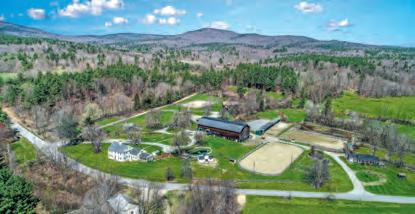
ROBIN MIGDELANY | C: 781.640.0337
of Grand Monadnock Mountain. PETERBOROUGH, NH | $8,500,000 | MLS# 4921409 ANDY PETERSON | C: 603.496.9172
a sunset
Heritage Farm
TEMPLE,
HERITAGE FARM
PETERSON
4911531
C: 603.496.9172
the
COUNTRY HILLSIDE PROPERTY
NY | $4,899,900 | MLS# 202225534 APRIL SENEY | C: 518.669.5240
country living,
equestrian facilities,
open fields,
and
view
features, Stepping Stones Lodge,
main farm, guest houses and equestrian amenities. A singular legacy farm available after 27 years of loving ownership.
NH | $2,100,000 | MLS#
ANDY
|
STUNNINNG
300 ACRE LOT Free of conservation and agricultural easements. A good mix of rolling hills/fields and undisturbed forest. LEBANON, NY | $1,900,000 | MLS# 202222263 APRIL SENEY | C: 518.669.5240 MARK TWENTYMAN | C: 518.573.7320 SARATOGA O: 518.580.8500 | PETERBOROUGH O: 603.924.3321 | CATSKILL O: 518.943.7533 | KINGSTON O: 845.331.3100 | ST. JOHNSBURY O: 802.751.7582 | FAIRLEE O: 802.333.4701 23 Offices Throughout Vermont, New Hampshire & New York. | Each Office is Independently Owned and Operated. FourSeasonsSIR.com
This four bedroom, three and half bath home is set on 41.76 acres of rolling hills and scenic views. It includes horse boarding facilities, indoor riding arena and fenced pastures. MARSHFIELD, VT | $609,000 | MLS# 4931818 DARREN SHERBURNE | C: 802.598.4584 16 Burke Road, Peterborough, New Hampshire Don’t just get your home on the market. Get it the attention it deserves. Nothing Compares.

RANSOME ROMBAUER
hen Ransome Rombauer’s parents signed her up for Friday night Saddle Club at a small local lesson barn, it was an opportunity for her parents to have a date night and introduce her to horses, barn chores, and groundwork. She loved it so much that it evolved into spending many days after school and full time during the summers throughout her grade-school years.
“Sunrise Stables was a very rustic and down-to-earth experi ence,” Ransome said. “Before any of the campers were allowed to ride, we were required to learn how to muck stalls, pick hooves, groom, and properly feed the horses. I gained a solid foundation in horsemanship before I could even walktrot. For that, I am truly grateful.”
In the early ‘70s, Ransome’s grandpar ents, Koerner and Joan Rombauer moved their two children, two Quarter Horses, and a pack of Sheltie dogs from Texas to the Napa Valley, where they ultimately founded Rombauer Vineyards in 1980.
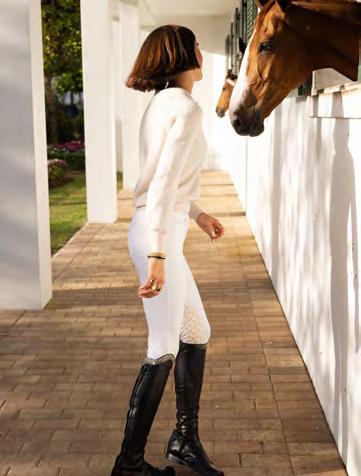
Ransome got the horse-lover gene from both sides; her father, Koerner “KR” Rombauer III, grew up doing 4-H throughout his youth, and his love of animals, farming, and horses definitely rubbed off on Ransome. Her mother, Laura, grew up riding horses on the mountain trails at North Lake Tahoe. Appreciation for food and wine already ran deep in the fam ily. Grandpa Koerner’s great-aunt Irma Rombauer wrote the American kitchen staple cookbook The Joy of Cooking, and his German ancestors had deep roots in the winegrowing region of Rheingau.
Over four decades later, Rombauer Vineyards is now a thirdgeneration family-owned-and-operated winery renowned for its signature Carneros Chardonnay. “I remember tagging along with my dad doing wine-tasting tours at the winery and meeting customers at wine dinners. Everyone I knew growing up and where I went to school were con nected to the wine industry,” Ransome noted. “It’s crazy to think that all my friends were a part of Silver Oak Cellars, Schramsberg Vineyards, Duckhorn Vineyards, Spottswoode Winery, Aubert, and many more notable California wine brands.” Though the wine business isn’t Ransome’s primary focus, it definitely is part of who she is.
Like many young West Coast riders, Ransome spent most of her junior career in the equitation ring training with Daniel Ighani (Ighani Sporthorses) and Karen Healey. With many top finishes under her belt, moving into the jumper ring once she aged out of the juniors was a logical shift in focus. Ransome spent the final semester of her senior year of high school in Wellington, training full-time with Ashland Farms and Spencer Smith. She
NOVEMBER/DECEMBER | 2022 | EQLIVING.COM | 51 W Continued on page 54 INTERVIEW BY MAGGIE CARTY PHOTOS BY GEORGE KAMPER | CHASE HALL RIDING AND RESCUING
Ransome at home in Napa Valley, California, with many of her rescued miniature horses.

52 | EQUESTRIAN LIVING | NOVEMBER/DECEMBER | 2022

NOVEMBER/DECEMBER | 2022 | EQLIVING.COM | 53 PHOTO CHASE HALL
graduated from Southern Methodist University (SMU) in the spring of 2021 after commuting back and forth from Dallas to Wellington each season and spending summers competing at Spruce Meadows with Spencer. During this time, Ransome got to know Eric Lamaze, as Eric was training Spencer then and had also sold Ransome her jumpers over the years. “Spencer started traveling a lot more for his own career, and it made sense for me to make a change and move to Eric’s barn, Torrey Pines,” Ransome said. Eric knew my horses, knew me, and we really hit it off. He has a way of instilling self-confidence, and I have matured as a rider under his guidance and in his program. It has been a great partnership and the right move in my career.”


Since early this summer, at the end of WEF, Ransome has been showing through out Europe, including a few Global Champions Tour shows and some of the more regional 3*** shows in Belgium, closer to the Torrey Pines home barn outside of Brussels. “I have my two jumpers at the barn, but there are always many young horses and sale horses for me to ride, flat, and lesson on, which is great and has given me a lot of extra time in the sad dle. This summer is the first time I have been able to focus on my riding 100 per cent and not have the grind of managing school and university in between com muting to competitions. I am so grateful to have the opportunity to be a part of
This spread: Ransome enjoys training with Eric Lamaze and the camara derie and sense of team at Torrey Pines. (Shown here at the Wellington location.)
such an established training program and be surrounded by such great people. It’s very exciting. I love the barn culture, the team camaraderie, and the buzz that goes on every day,” Ransome said. She will keep her horses in Belgium through mid-December and then head straight to Florida for the 2023 winter circuit with the Torrey Pines team.
Though competition has been her focus through out her riding career, Ransome has always had a soft spot for horses and other animals in need.

“Animal welfare has always been one of my passions, and I grew up being around animals and horses at a local horse res cue,” Ransome added. “During high school, I became aware of Brooke USA, a fundraising arm for an international equine welfare organization, and I started donating my competition prize money. Simultaneously, I became more and more aware of the issues of kill pens and the movement of horses from the USA to Mexico and Canada for slaughter.” This was a time when everything clicked for Ransome, and she realized she needed to do something. It all started with a Craigslist ad and taking on a family of feral miniature horses living in squalid conditions in a residential backyard while being terrorized by little kids. Little did she know, the mare was pregnant, and soon the family of three became four! It was only the beginning and thankfully Ransome had supportive parents who turned a blind eye as she added to her
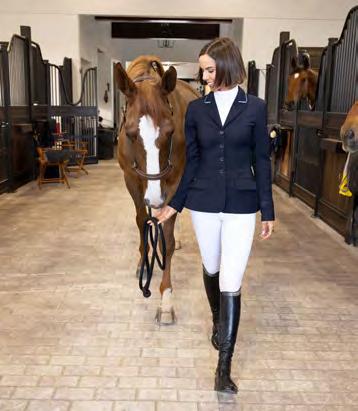
Continued from page 51
PHOTOS THIS SPREAD GEORGE KAMPER
Continued on page 58 54 | EQUESTRIAN LIVING | NOVEMBER/DECEMBER

This spread: After busy periods of travel and competition, Ransome relaxes at the family’s Napa Valley home, spending time with her menagerie of rescues and riding in the vineyards. Inset: Ransome, as a young horse lover, with her proud parents.


 PHOTOS THIS SPREAD CHASE HALL
PHOTOS THIS SPREAD CHASE HALL
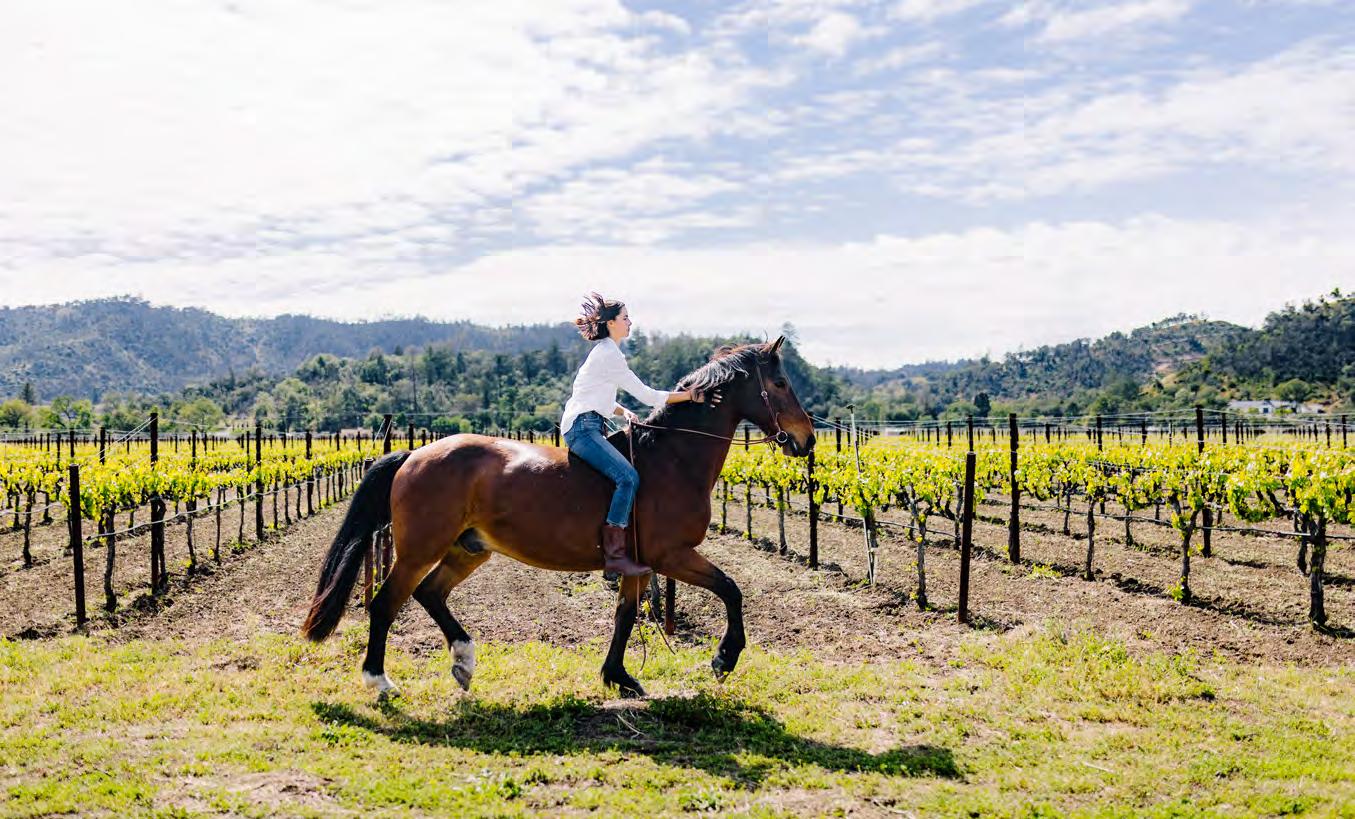


NOVEMBER/DECEMBER | 2022 | EQLIVING.COM | 57
herd of rescue minis, including a few that were rescued out of a kill pen in Texas and hauled back to California.
The experience of taking on neglected horses, rehabbing them, and bringing them back to life was truly rewarding. Ransome didn’t stop at just minis. The Rombauer family has taken on numerous rescue horses and has recently added rescue dogs to the menagerie. It has come to a point where, between retired show horses and the rescue horses, Ransome currently has 14 in her herd that she manages with the help of her par ents. Needless to say, Mom and Dad have said that is enough —no more horses!
While attending SMU in Dallas for four years, Ransome struggled with being away from her rescues at home. She started regularly volunteering at Dallas Animal Services and the Fort Worth Animal Care and Control to fill her nurturing need. Her love of animals and her special connec tion with creatures in need paved the way for many, many, volunteer hours at the shelters. “I love rehabbing animals, identifying the ones that are in the worst condition and over looked, and bringing them back to life,” she said. “It makes me so happy and satisfied to be a part of their transformations. It’s one of the most rewarding things I have ever done.” Fort Worth Animal Care and Control is one of the largest cityowned dog shelters in the country. “There are over 1,100 dogs at the shelter right now,” she says. “It’s a complete nightmare.” Irresponsible backyard breeding, lack of sufficient spay and neutering services, and so many people surrendering pets, have filled the Texas shelters beyond capacity.
So, Ransome took on a new shelter dog, rehabilitated it for a semester, took it home to the Napa Valley, and started all over again with another rescue the following term. “So, we have five dogs at home at the moment from the Texas shelters, and my parents say ‘No more!’” she laughed. “I really have a soft spot for helping animals, and so does my mom, but at this point, my dad has cut me off from adding more animals to our four-legged family.”
“I think this is my calling and my way of giving back to the horse and dog rescue community,” she continues. “I think it’s easy to get caught up in the show scene, and it’s hard to remember that there are so many unwanted horses and dogs out there—especially in Texas. I see so many. It’s hard, but it’s important to me, and hopefully, my volunteer and rescue efforts make a tiny bit of difference.”
Ransome competes in the U.S. and throughout Europe, including at the Global Champions Tour shows. One of her favorites on the tour is in Paris, where show jumpers navigate the course with the city’s iconic Eiffel Tower in the background.

58 | EQUESTRIAN LIVING | NOVEMBER/DECEMBER | 2022
BOSS MARE MEDIA
Continued from page 54

 CeCe Durante Bloum with Hef and Bo at Newmarket Farm, home to Thrive Animal Rescue.
CeCe Durante Bloum with Hef and Bo at Newmarket Farm, home to Thrive Animal Rescue.
BY JILL NOVOTNY
JIMMY DURANTE’S DAUGHTER DEDICATES HER HOME AND FARM TO RESCUE DOGS.
A
CECE BLOUM
s I exited the highway, I could see the Del Mar fairgrounds along Jimmy Durante Boulevard and the glittering ocean beyond. The famous venue, home to the Del Mar Thoroughbred Club and racetrack, was founded by Durante, Bing Crosby, and Pat O’Brien in 1937, just one mile from my destination: his daughter CeCe Durante Bloum’s farm and site of Thrive Animal Rescue.
Checking the GPS, I felt certain I had the incorrect address as I passed through a neighborhood of large Mediterraneanstyle, 3-garage homes tucked tightly into each other’s shadows. But, suddenly, the road swung down into the valley and opened into a rustic farm lane, tails swishing in the paddocks on either side.
I turned in the drive of Newmarket Farm, greeted by a choir of puppies bark ing from their shaded enclosure in front of the barn. CeCe stood in the doorway, her tall figure calling cheerfully from inside the barn. The farm, and CeCe’s home for 30 years, was bustling with activity; feed deliveries, golf carts loaded with dog food, and horses being turned out.

CeCe’s love of animals started early. She would round up animals to bring home to her mother, Margaret Little, and her father, beloved entertainer Jimmy Durante. Though they only kept poodles at their Beverly Hills home, CeCe would spend hours at the local pet store and compel her parents to take her to the nearby Beverly Park (now the site of the Beverly Center shopping mall) for count less pony rides.
Bloum was a successful amateur rider on both the East and West coasts before she turned professional and established Newmarket Farm with her husband, Stephen. There, she ran a successful show barn for decades, boarding upwards of 75 horses.
NOVEMBER/DECEMBER | 2022 | EQLIVING.COM | 61
Continued on page 66VINCENT KNAKAL / RANCH & COAST MAGAZINE
This spread clock wise from upper left: CeCe Bloum (at far right) with the dogs and people of Thrive Animal Rescue on the shaded green doggy patio; A California pepper tree provides a shady spot to relax in the Bloums’ backyard; A photo of CeCe’s father with a lineup of Hollywood stars; Newmarket farm is just two miles from the beach; The focal point of the expansive living room is a painting over the fireplace of twoyear-old CeCe with her parents, Margaret and Jimmy Durante. His piano is in the foreground; The 12-acre property includes a pool (where the dogs like to swim), water slides, and enter tainment areas; Founded by CeCe and her hus band, Stephen, over 30 years ago, Newmarket is a training and board ing farm in Del Mar, California.



EXCEPT AS NOTED PHOTOS BY VINCENT KNAKAL / RANCH & COAST MAGAZINE




 JILL
JILL
NOVOTNY
JILL NOVOTNY
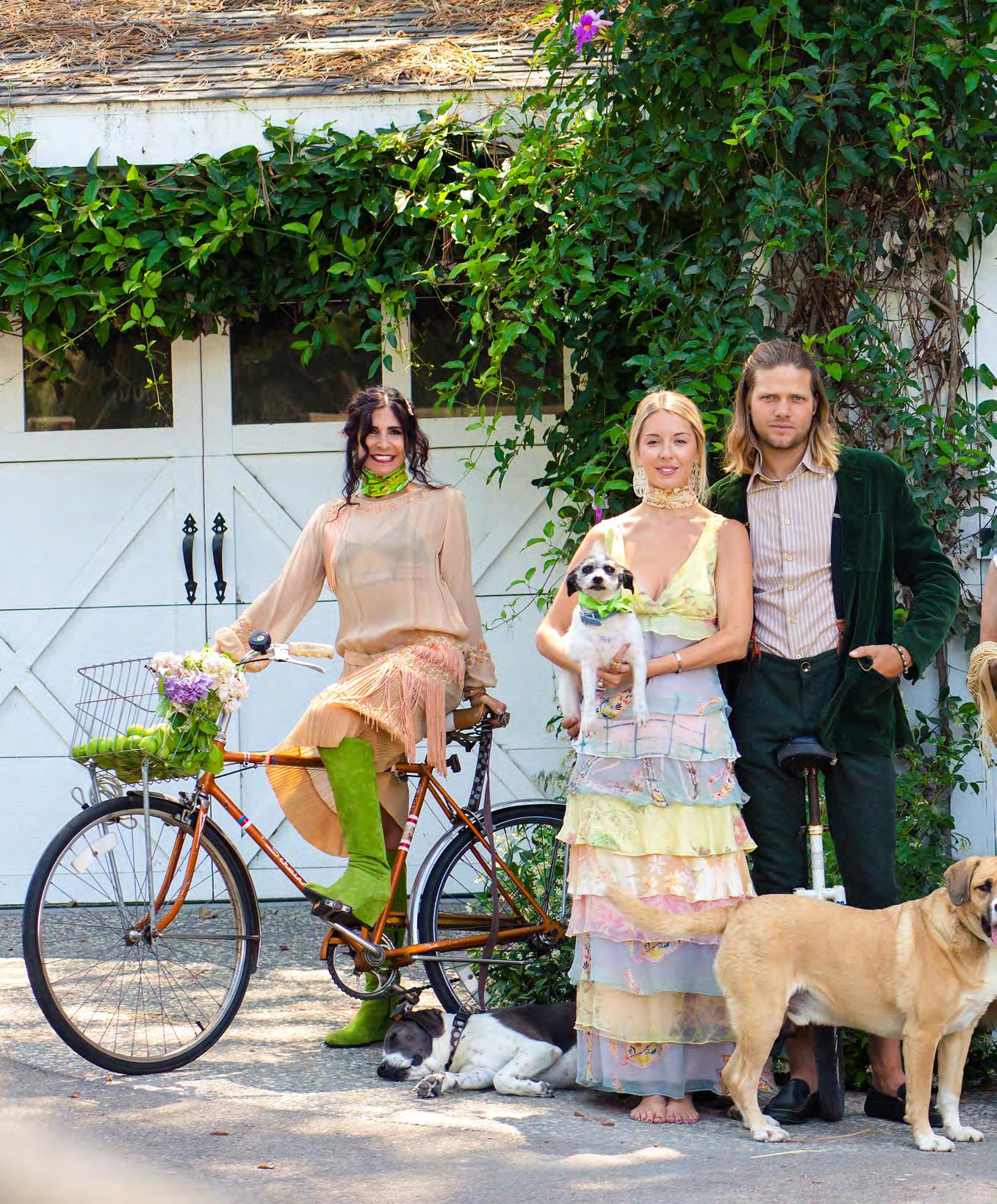
adoption is the hip option. —Thrive Animal Rescue website

Because
PHOTO COURTESY OF THRIVE ANIMAL RESCUE
When CeCe retired from the busi ness in 2010, she turned her attention to rescuing dogs. Thrive Animal Rescue, a nonprofit whose mission is to rescue and rehome abandoned dogs across Southern California, was founded in 2014 by Bloum and fellow equestrian Georgia Spogli. Today, the organization scours the streets and shelters of Los Angeles, San Diego, and nearby Calexico and Palm Springs, looking for dogs in need of help. Coco Worrell works as the trainer and behaviorist and does much of the ani mal care, along with CeCe and a host of volunteers.

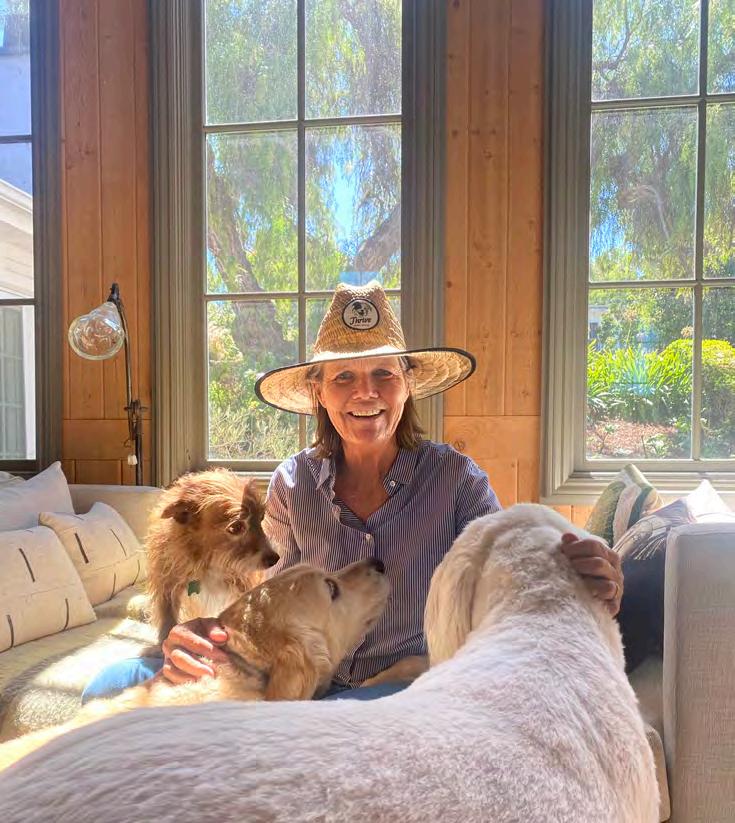
She pointed to the puppies and explained that they were amid a “puppy explosion.” Her recent adoptees, three adult female dogs, had all turned out to be pregnant simultaneously and had all given birth within a week, leading to a

mega-litter of 26 puppies (of which 12 are left still to be adopted).
“My office has been taken over as the ‘maternity ward,’” she laughed. “We can just chat out here if that’s ok.” I peeked into her office, now the site of a soft mass of tangled tails, fur, and snouts, snuggled in a warm, sleepy pile. “I’ll just sit here on the ground; you take the chair!” she offered brightly as she sidled up to the mother of one of the puppy litters on a dog bed.
Much like CeCe her self, the property had a warm charm and natural beauty. Not overly manicured, the grounds were none theless stunning. The artfully designed barn and its surroundings showcased the
natural beauty of the locale. It was bright and tidy, yet lived-in and comfortable.
A cool ocean breeze that drifted down the barn aisle offset the warm California sun, an unusual but luxurious sensation. We stepped outside and climbed the steep path together to the top of the hill, where a new building was being erected. “We used this area for school horses, but we’ve expanded Thrive now to be up here,” she explained. “This new building will give us more room to take in dogs.”
The rescue is as lovely a home as any dog could have, atop the sunny hill over looking the 12-acre horse farm and out to the Pacific. An inviting, shaded seating area surrounded the play space’s clean green turf, littered with fresh-looking dog toys and cool water bowls. The dogs I met, two sets of bonded pairs, each had an area to themselves the size of a small
66 | EQUESTRIAN LIVING | NOVEMBER/DECEMBER | 2022 continued from page 61
PHOTOS THIS SPREAD: JILL NOVOTNY
apartment, complete with a shady patio off to one side and access to the play areas on the other. They frolicked with toys, rolled over for belly rubs, and laid out for a nap. The senior dogs that made their way out to greet us enjoyed the sunshine before contentedly ambling back into their cozy little cottage.
“Thrive offers what we call a ‘forever foster’ program for senior dogs, where we will pay the necessary vet bills. It can be very hard to get them adopted when they have expensive needs,” CeCe explained. Thrive supports adopters with train ing and daycare, and fostered dogs have the chance to run and play on the farm whenever they’d like.
Finally, CeCe introduced me to a group of dogs rescued from a hoarding situation, still wary of their new sur roundings. It was a stark reminder to
me that Thrive is much more than just a paradise of happy dogs. The job of rescuing dogs is heroic, difficult, and heartbreaking.
We headed back down the hill via the house’s back yard for a short visit with CeCe’s own dogs; five “foster fails” of various ages and breeds. Her home, dotted with memorabilia to make any Hollywood fan’s jaw drop, is cheerful and airy, with the same effortless class that CeCe exudes. I stepped through the living room, past Jimmy Durante’s piano, to snap a photo of a framed note from Frank Sinatra. CeCe pointed out a photo on the wall of an incredible lineup of nearly 100 Hollywood stars, including
Clark Gable and Katherine Hepburn, her father seated among them. Then, we step back outside to visit once more with the pile of puppies before I set back out. Jimmy Durante, who was famous for his authenticity, likeability, and good humor, has had an obvious influence on his daughter. Though life on the farm may be a far cry from her Beverly Hills childhood, CeCe Durante Bloum is spreading goodness in the world, much as her father did.
Far left: Adopters meet their newest family members on Thrive’s website. This page: The 12-acre farm has views to the ocean.

NOVEMBER/DECEMBER | 2022 | EQLIVING.COM | 67
CONTACT INFO | PAGE 92

68 | EQUESTRIAN LIVING | NOVEMBER/DECEMBER | 2022 BETSY STEIN
BY SARAH LESSLER
DEDICATED TO HORSE WELFARE
TLYNN COAKLEY
he EQUUS Foundation, a name that has become widely known in the equine community, is recognized in the industry as one of the most influ ential equestrian charities in the country. Their mission is to protect America’s horses from peril and strengthen the bond between horses and people. As founder and president, Lynn Coakley has created a non-profit network that has saved countless horses’ lives and aided in helping them find new roles and loving homes. She is a determined woman who has had a unique influence in the equestrian world.
Lynn grew up riding at the Fairfield County Hunt Club, (FCHC) in Westport, Connecticut, as did her mother, and even tually, her two daughters. As her daughters began to show an interest in riding, Lynn moved to a house that backed directly up to the hunt club. The two young girls had an enviable child hood: getting off the school bus and tacking up horses in their backyard barn to walk over for lessons with legendary hunterpony trainer Emerson Burr. Together they enjoyed taking care of the horses, and they both went on to have successful competi tive riding careers.
It was after Lynn’s daughters headed off to college that the EQUUS Foundation became a vision. Lynn asked herself, “My kids are gone; what do I do with the horses next?” and began researching options. Lynn learned that tens of thousands of horses are sent to auctions where owners are led to believe that their horses could find good homes. But many horses risk being purchased by a kill buyer to be sent across borders to slaughter. This reality was unacceptable to Lynn and jump-started her journey into finding alternative careers and homes for horses. In
response, she wanted to raise funds to allocate for organizations giving horses careers outside of competition.
The EQUUS Foundation began in 2003. Lynn explains, “When my children started riding, and I also got back into rid ing, I accepted the volunteer chairmanship of the Fairfield June Benefit Horse Show. Under my leadership and with the support of the FCHC board, Emerson Burr, and Billy Glass (the show manager at the time), we established the first Fairfield Grand Prix and arranged to have a luncheon in association with the event that could benefit a charity,” adds Lynn.
There were several different charities involved in the first few years, and recognizing that there was the potential of rais ing a significant amount of funds, the EQUUS Foundation was established to be able to receive the donations and disburse grants to multiple charities instead of just one. “We com pleted our first year of operation and awarded our first grants in August 2003 to the ASPCA Lucky Fund, which later became the ASPCA Equine Fund, the Bridgeport Police Mounted Unit, Green Chimneys Children’s Services & School, High Hopes
NOVEMBER/DECEMBER | 2022 | EQLIVING.COM | 69
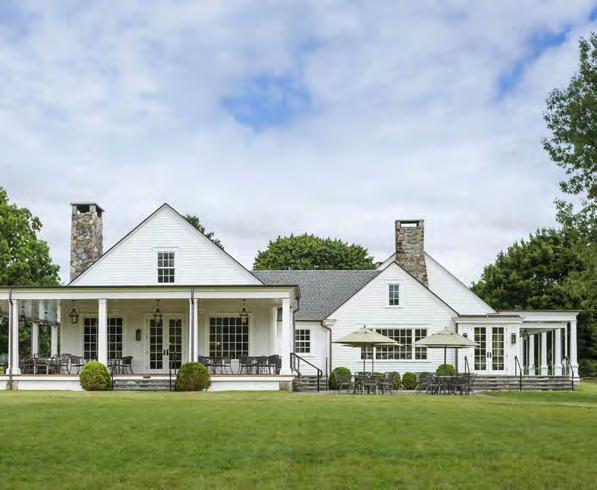



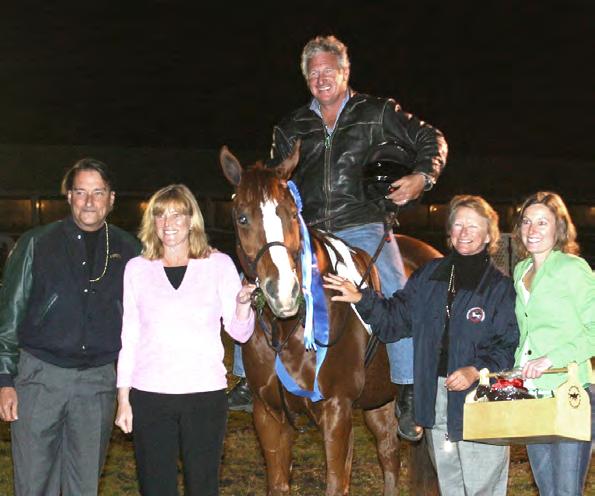
 ARCHITECT: MARK FINLAY, PHOTOS: WARREN JAGGER
ARCHITECT: MARK FINLAY, PHOTOS: WARREN JAGGER
Therapeutic Riding, The Hole in the Wall Gang Fund, H.O.R.S.E. of Connecticut, Pegasus Therapeutic Riding, and US Equestrian Federation Emerson Burr Horsemanship Award,” says Lynn.
Opposite: 1.2. (Clockwise from upper left)
The Fairfield Hunt Club clubhouse. 3. Emerson Burr was Fairfield County Hunt Club’s stable manager for over 50 years. Burr died in 2001.
4. EQUUS Foundation Equestrian Idols (left to right) Brian Lookabill, Ki-Juan Minors, Patricia Griffith, and Taylor Blauweiss Hughes. 5. Frank Madden awarded 1st Prize at the EQUUS Foundation’s 1st Fete Cheval in Wellington; (Left to right) Mason Phelps, Lynn Coakley, Frank Madden, Sue Ashe, and Jenny Belknap Kees. 6. (Left to right) Lynn Coakley, Catherine Herman, and Jenny Belknap Kees at the 2020 Winter in Wellington event; SAVE THE DATE: Sunday Evening, March 12, for the 2023 Winter in Wellington 20th Anniversary Celebration.
For the first years of the foun dation, they localized their awareness and giving to Fairfield and Westchester counties. “The FCHC played a pivotal role in the EQUUS Foundation,” Lynn states. But Lynn’s vision grew and her sights were set broader. There were equine organizations across the nation that needed funding and horses needing a new life after sport. Lynn remarked that she learned that horses are work ani mals by watching her horses in the backyard. “Our horses liked having jobs and would get bored if they couldn’t do them,” she says.
The time had come to take the EQUUS Foundation to Wellington, Florida. The foundation put on two major fund raising events. The Fete Cheval brought top show jumpers like McLain Ward, Kent Farrington, Beezie Madden, and others to the International Ring at WEF to compete in gymkhana games using horses from local rescues and lesson programs. Another major event was Equestrian Idol, where riders could showcase their other talents in front of crowds, and a panel of champion show-jumping athletes served as the judges. These events cul tivated an opportunity for the top riders across the country, and the local Wellington community, to come together to raise money and awareness of what rescue horses could do and become.
By 2010 the EQUUS Foundation had awarded over $1.5 million in donations to equine charities, and Lynn’s dreams for her founda tion continued to grow. However, she could not have anticipated receiv ing a bequest from a single donor of approximately $500,000 in 2014, which let the foundation rebrand and strategize. “It allowed us to cultivate real donors and not have to rely solely on event revenue,” Lynn said.
“Since 2014, under the leadership of Jenny Belknap Kees, the Chair of the EQUUS Foundation since its founding, and Catherine Herman, who has served as Vice Chair since 2006, we established new programs like Next Chapters and Safe Landings aimed at ensuring the safety and dignity of horses throughout their lives,” said Lynn. “This Fall marks the start of our 20th Anniversary year. We have set an ambitious goal to raise $2 million to double our investment in equine charities making a difference in the lives of America’s horses and double our endowment. We are committed to reducing the number of horses sent across our borders for slaughter with the goal to reduce the number to zero. None should be subjected to inhu mane death and the fate that awaits them—especially because there are solutions within our reach. In addition to competi tive and recreational programs involving horses, programs providing equine-assisted therapeutic services offer endless opportunities for careers for horses in transition. Horses have the amazing ability to inspire, empower and heal.”

NOVEMBER/DECEMBER | 2022 | EQLIVING.COM | 71
BETSY STEIN
Above: Lynn Coakley and Valerie Angeli.
The elevation of the EQUUS Foundation’s image also included bringing on part nerships with the equestrian indus tries’ top-performing riders, horses, and owners. The foundation’s alli ances include EQUUStars, Athletes, Equine Ambassadors, and other national equine organizations—all of which are committed to the welfare of horses, whether they are athletes, companions, teachers, or healers. The EQUUS Foundation’s unique Guardian program offers equine charities a rig orous and comprehensive screening application to qualify for funding. The Guardianship program ensures that organizations meet the EQUUS Foundation’s guidelines for equine welfare and public account ability to qualify for EQUUS Foundation grants. Donors can also give directly to the Guardian charities listed on the EQUUS Foundation Equine Welfare Network.
Above: A sunny day in late August for the annual Hampton Classic Adoption Day sponsored by Georgina Bloomberg, EQUUS Foundation EQUUStar and top international equestrian. The day was dedicated to finding homes for adoptable horses, dogs, and cats. Over 300 attendees came to cheer on adopt able horses and learn more from Gerda’s Equine Rescue, Vermont; New England Equine Rescue, Massachusetts; Omega Horse Rescue, Pennsylvania; Retired Racehorse Project, Maryland; Return to Freedom Wild Horse Sanctuary, California; and Rising Starr Horse Rescue, Connecticut.

Opposite: (Clockwise from upper left) 1. Georgina Bloomberg, her son, Jasper, and his adopted mini-pony, Teddy. 2. Brianne Goutal’s Mickey Blue Eyes that she rescued for her daughter, Clea. 3. Adoptable minis from Omega Horse Rescue pictured with Omega represen tatives, Shanette Cohen, Valerie Angeli, and Renata Solomou. 4. Serena Marron with Bumble from New England Equine Rescue. 5. Adoptable horses and representatives from Rising Starr Rescue. 6. The HEART Equine Ambulance.
and Valerie Angeli, the vice presi dent of engagement for the EQUUS Foundation, lit up when talking about Georgina Bloomberg’s son, Jasper, and his adopted mini-pony, Teddy. They described Teddy as a “scruffy, full-of-manure mess from the auction” when he was adopted, but with good grooming and proper nourishment, he transformed into a tiny champion. Jasper instantly fell in love with Teddy, and the rescue pony taught him how to ride. Another amazing suc cess story of an adopted rescue horse is Brianne Goutal’s Mickey Blue Eyes. Brianne rescued Mickey for her daugh ter, Clea, and trained him herself. He has become a huge part of their family, hanging out in their house and winning ribbons at the Hampton Classic. Both Georgina and Brianne serve as EQUUS Foundation EQUUStars, along with actress Beth Behrs, Clementine Goutal, and Jessica Springsteen.
When asked about some of the foundation’s most cher ished feel-good stories, Lynn offered many to choose from. She
Valerie says, “There is a champion in almost every horse if you give them the chance.” Adds Lynn, “We prove that everyday.”
72 | EQUESTRIAN LIVING | NOVEMBER/DECEMBER | 2022
KRISTIN GRAY
CONTACT INFO | PAGE 92


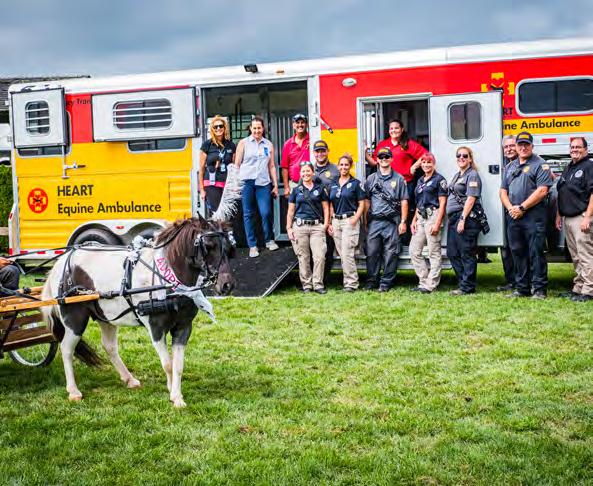



NOVEMBER/DECEMBER | 2022 | EQLIVING.COM | 73
KRISTIN
GRAY
KRISTIN
GRAY
KRISTIN
GRAY
KRISTIN GRAY

74 | EQUESTRIAN LIVING | NOVEMBER/DECEMBER | 2022
BY SARAH LESSLER PHOTOS BY GEORGE KAMPER
AGAIN AFTER
BREAK
TJULIE HOLZBERGER
here is no doubt that bal ancing academics, career, family, and competitive riding is difficult. Many riders find there is a time when career and family life have to take priority over horse shows. However, this often leaves a void and an unfulfilled passion. Such was Julie Holzberger’s reality, but she has been lucky enough to find her way back to the horse-show world after a 25-year break from horses, and she has made quite the comeback.

Julie was born into a family that loved horses and enjoyed fox hunting in Ohio. Her father even shoed his own horses. Julie got her first horse at 6 years old and has fond memories of time spent at a nearby lake with three or four children riding the horse at one time. Originally, Julie was not a competitive rider, and her family kept the horses at their home, with everyone pitching in on the daily barn chores. When it became clear that Julie wanted to ele vate her riding, her parents allowed her to move her horse to a boarding barn to take lessons and start competing. Her riding evolved into competing in the pony hunters and then the junior hunt ers’ divisions. However, she always had to prepare her horses and participate in the barn work. “It was never a free ride,” Julie remarks. She remembers being at shows at 4 a.m., braiding her
ponies and getting them ready before a show. She adds, “I attribute my discipline in anything to my upbringing.”
Following high school, Julie contin ued her education at Miami University of Ohio. She found she wasn’t interested in the riding opportunities there, which initiated a long break from riding. She concentrated on her schooling and, upon graduating, focused on furthering her career. Julie’s career is impressive and shows perseverance, dedication, and innovative thinking. She and her hus band, Frederic, opened 11 Aveda retail stores and are co-founders of the Aveda Fredric’s Institute, an industry-leading educational program for cosmetologists, estheticians, and wellness professionals. Together, they created a revolutionary place for aspiring professionals to learn a trade and further their skills.
Julie and Frederic are also passionate
NOVEMBER/DECEMBER | 2022 | EQLIVING.COM | 75
A CHAMPION
A 25-YEAR
about philanthropy and giving back to their communities. They have numerous outlets for the betterment of others, starting back at the grassroots level of their Aveda Institutes. Project Daymaker, a mobile salon created in a Winnebago, staffed by salon volunteers traveled to various locations to provide complimentary styling services to women, men, and children in need. Additionally, Julie and Frederic have made impactful donations to Ohio-based healthcare facili ties. At the Christ Hospital, the Julie and Frederic Holzberger Cardiovascular Nursing Excellence Fund has provided the hospital with the ability to recruit, train, and retain the high est quality cardiovascular nurses for their program. The Julie and Frederic Holzberger Nursery at UC West Chester Hospital gives back to women, who make up the majority of the work force in the salon and spa industry. Julie also has been involved in Ohio therapeutic riding chapters and numerous animal res cue groups, including Brooke USA
So, after 25 years of dedicating her life to her work and family, what brought Julie back to her childhood passion of horseback riding? One day, Julie was browsing through an equestrian magazine that had arrived, and she remembers see ing a beautiful picture of a horse and staring at it. “I took the magazine, and I kissed it. I kissed the horse in the magazine,” Julie laughs. She says that her husband saw her kiss the horse and told her that she needed something other than work in her life. At that moment, all her feelings about riding horses came rushing back.
Her initial plan was to simply trail ride and have her husband, who had never ridden before, join her as something they could enjoy together outside of work. To her sur prise, her husband bought her a 5-year-old horse named Dani, a beautiful gray Quarter Horse. Her husband chose not to continue riding; however, Julie was introduced to trainers David Belford and Christopher Payne of New Hope Farm, who had just moved to Cincinnati, Ohio, and were renting a farm to start their training business. Julie was their first client 18 years ago, and she continues to train with them today.
Still, her picture of riding was to trail ride for fun, but after meeting Chris and Dave, the next thing Julie knew, she was in Wellington, Florida. She leased a horse during her first season there just to get into the show ring. Ultimately, they found a horse for her to buy named Pure Giving. The new pair stepped right into the adult hunters with great success. Julie had refound her passion.
When asked what she attributes her success to, Julie says it’s her training. “My initial training. It all starts at the grassroots. I had such a great foundation, and it all begins with your baseline education.” Julie feels that she was able to go back to
Above: Julie and Imagine, her Westphalian, were WEF circuit champions in the Adult Amateur Hunters two years in a row.
Opposite: The talented team of Julie and Imagine pause for a photo on their way to the barn.
 PHOTO BY SPORTFOT
PHOTO BY SPORTFOT
76 | EQUESTRIAN LIVING | NOVEMBER/DECEMBER | 2022
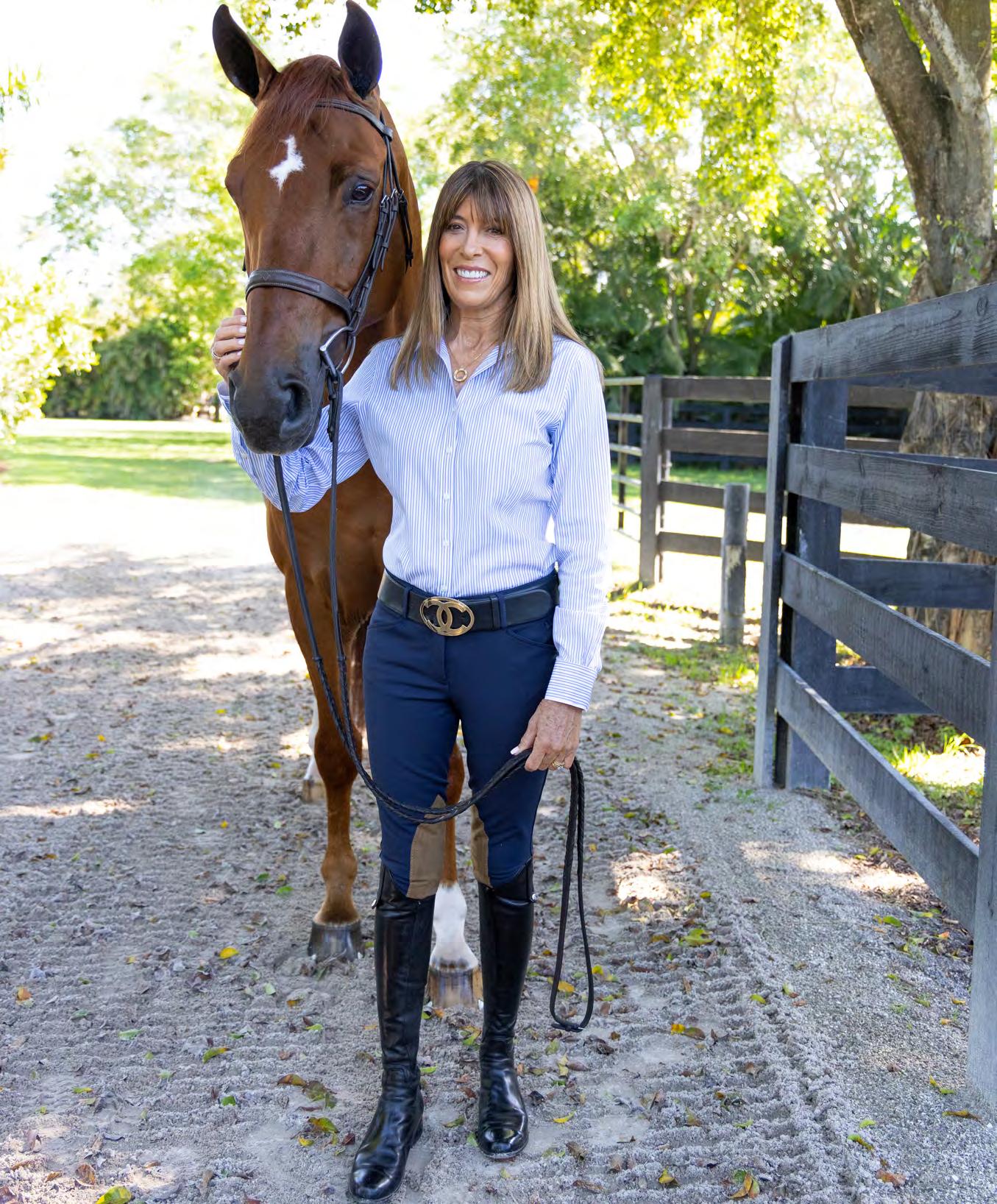
NOVEMBER/DECEMBER | 2022 | EQLIVING.COM | 77

78 | EQUESTRIAN LIVING | NOVEMBER/DECEMBER | 2022
Opposite: Julie feels relaxed at the stable on a rare day off. Her disciplined and healthy lifestyle helps her to maintain a balanced mindset in the competi tion ring and at home. This page: The lush and peaceful setting of her training barn.

the equestrian sport after 25 years out of the saddle because of her strong beginnings. After nine years of competing with Pure Giving and achieving numerous championships, including Capital Challenge Adult Amateur Hunter Champion and North American League Adult Hunter Final, Julie decided to retire him. She thought she had accomplished all she needed to and would be fine on the sidelines of the ring. But then her trainer, Dave, sent along a video of an amazing chestnut Westphalian. Despite trying to convince herself she did not need this horse, coming up with all the negative “what ifs” like if he is not comfortable or can’t see a distance, her trainer said to her, “But what if he is?” And the rest was history; Imagine, the Westphalian, came over from Europe and was the next addition to Julie’s family. Julie and Imagine went on to be circuit champions in the Adult Amateur Hunters two years in a row at WEF.
Julie’s confidence and trust in her trainers at New Hope Farm let her know that she will be safe when she gets on her horse and that her horses are being cared for and meticulously monitored. “It is a team approach, and communication is key for all members,” Julie says.
When asked how she balances it all, Julie explains, “I compartmentalize all pieces of life.” Riding is the part of her life that helps her to decompress and feel replen ished. “I boil it down to communication and putting a timeline on my days at the barn, my work obligations, my family, and my social functions,” she says. She loves her nightly to-do lists that aid in organizing and structuring life. Julie has tremendous support from her hus band, who encourages her to ride even when she feels like she doesn’t have time to get to the barn. “You can’t wait for things to be easy to decide to be happy,” he tells her. When compet ing, Julie adheres to a strict regimen. She walks or runs five times a week, gets massages, goes to sleep early, eats healthily, and even has particular systems at the ring that make her feel competition-ready.
Julie advises being open-minded to the evolution of what riding may look like after a long break and starting small. She recommends being a driver of the direction you want your rid ing to go, but to be flexible and let the plan unfold. “Being realistic about the time you have to commit to riding and doing the research to find the right training program is paramount,” she explains. Julie never thought she would be where she is today, but she says structure, focus, and hard work played into getting her here.
NOVEMBER/DECEMBER | 2022 | EQLIVING.COM | 79

A DAIRY BARN DREAM RENOVATION
 WITH JOHN KING, OWNER, DESIGNER, KING CONSTRUCTION
WITH JOHN KING, OWNER, DESIGNER, KING CONSTRUCTION
Old barns are an important part of America and our history. While repurposing an existing building can be challenging, they have remained constant and are worth preserving. These structures have survived through many generations while all around them has changed. According to John King, “Collaborating with our clients and creating a space together that suits their needs is our primary goal.
“The owners of Brookview Farm contacted us about bringing new life to the barn that had become an eyesore on their prop erty,” King added. The original barn burned down in early 1900 and was rebuilt as a dairy barn in 1910. Fast forward 110 years, and its new owners wanted to renovate the structure into a space that would be useful and beneficial for their family and friends. While this barn had structurally stood the test of time, it lacked curb appeal and functionality and was no longer needed for farm equipment or livestock. After a thoughtful renovation, this barn now has charm and purpose—it has become an all-purpose family recreation center and garage.
It was very important to the owners to use as many natural elements as possible and preserve whatever they could from the old barn. However, updating needed to be done; things like replacing the dirt floor with brick were necessary. King was able to save the antique timbers and rafters and even repurposed an old dairy cow stall as framing for the new stairs. They were also able to reframe and reuse all the original interior doors on this
NOVEMBER/DECEMBER | 2022 | EQLIVING.COM | 81
DESIGN MASTER CLASS LEARN FROM AMERICA’S PREMIER DESIGNERS
Left: The 1910 dairy barn before its redesign into a garage and space for family and entertaining.
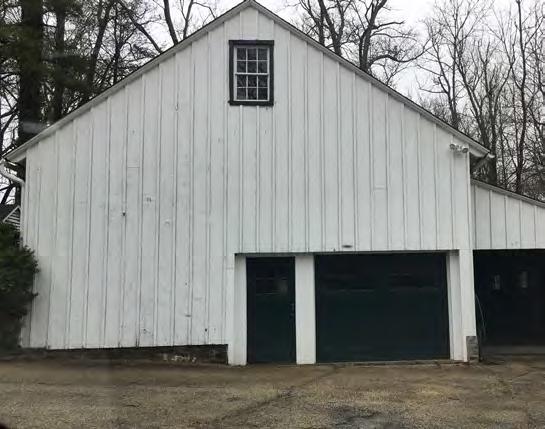
Right : A highlight of the new building is a dining room located where cars were once parked. It boasts a 16-foot-long table as a place for everyone to gather.
project. Even the old corn crib was repurposed into a spot to hold the garbage cans. All these elements combine beautifully to enhance the character of the barn.
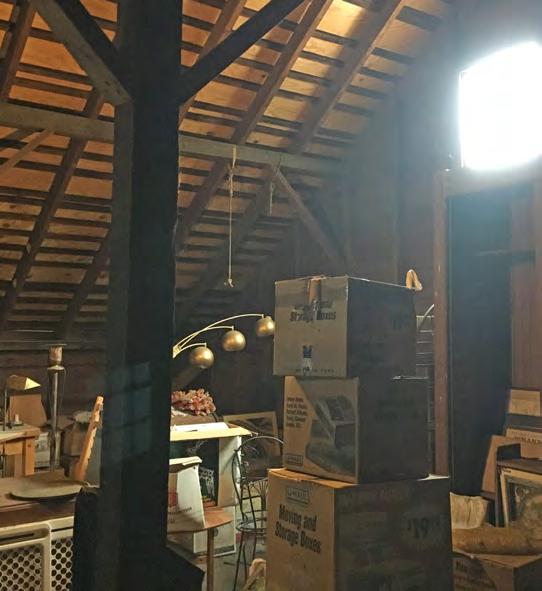
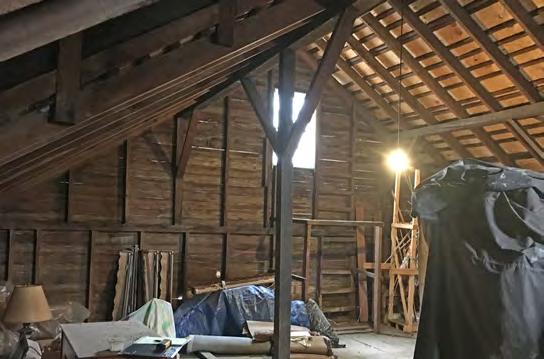
This barn is now a garage and entertainment space, outfit ted with all the modern conveniences you’d expect. There were windows added to maximize the amount of natural light. King created a cozy bedroom for out-of-town guests as well as a full bathroom and kitchen. A dining room located where cars were once parked boasts a 16-foot-long table as a place for everyone to gather. The rooms are now insulated, and horizontal shiplap was added to enhance the rustic charm. The stone fireplace on the second floor provides a stunning focal point and gathering place when the weather turns chilly.
When redesigning this project, one area that required thoughtful consideration was the garage. The original garage was turned into the new dining room, but the family still needed a functioning garage. To solve this, King added a twobay garage onto the opposite side of the original barn. This gave the family the area they needed to park vehicles as well as plenty of storage room above. It blends seamlessly with the original barn.
The exterior doors, custom-made of Spanish cedar in King’s woodworking shop, are both beauti ful and durable. King also added a cedar trellis over one entrance and a roof extension to cover the other doorway. These enhance the appear ance of the building and protect people from the elements when entering or exiting. Two custom cedar cupo las with copper roofs were added to the cedar-shingled roof for ventilation.
To make the space even more welcoming, the owners also wanted an outdoor space. King added an inviting porch off the dining room for guests to relax and observe the stream and chicken house below. At the request of the owners, King was able to match the fencing around their new, raised garden to the fencing in the front of their home. It is that attention to detail and the ability to accommodate special requests that make each custom build truly one of a kind.
King summarized, “The decisions you make when planning and building will determine how well a building will function for you. King Construction provides complete design services to help guide you through the process, making sure you are left with a place you can share for generations to come.”
82 | EQUESTRIAN LIVING | NOVEMBER/DECEMBER | 2022 CONTACT INFO | PAGE 92



NOVEMBER/DECEMBER | 2022 | EQLIVING.COM | 83
SARAH PAYNE
STEPS BOLDLY INTO THE WORLD OF PAINTING.
ARTIST INTERVIEW BY STEPHANIE PETERS
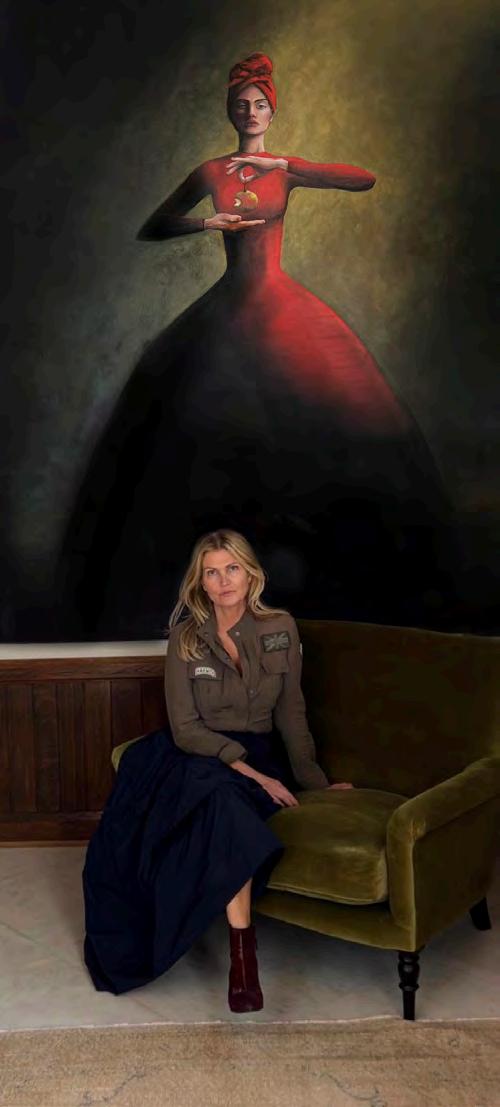 Artist Sarah Payne seated in front of her painting, Scarlett.
Artist Sarah Payne seated in front of her painting, Scarlett.
84 | EQUESTRIAN LIVING | NOVEMBER/DECEMBER | 2022

NOVEMBER/DECEMBER | 2022 | EQLIVING.COM | 85
Sarah Payne is a contemporary artist based in the U.K. Her strong back ground in photography and design led her to discover a skill for painting during the COVID lockdown. She had splashed a bit of paint on canvas over the years but began painting seriously in 2020. A following quickly ensued, with her first painting going to a col lector in Washington, D.C. She hasn’t looked back and is now a full-time artist.
A large body of Sarah’s work is equestrian-themed, but her scope encompasses a mixture of figurative and abstract paintings.
Payne works with a minimal color palette, uncomplicated backgrounds, and usually on a large scale for her equine portraits. “Although the paint ings are sometimes restrained, there’s always a hint of wildness and spirit in the horse’s expression, which I can attribute to the first time I saw George Stubbs’ Whistlejacket many years ago,” says Payne. “The impact of the painting resonated with me and has influenced my approach to painting horses.”
Represented by Una Malan in California, Sarah’s work sells worldwide and on social platforms under “Sassy Hardwick.”
Your background is in photography and interior design. What was the catalyst that encouraged you to paint, and what gave you the confidence to shift your full-time career to painting?
For me, the COVID 19 lockdown was the catalyst. My design work dropped off considerably, so I decided to try to paint something for my new house. Once I started, I couldn’t stop. I painted prolifi cally during that time and decided to post the finished pieces on Instagram to see if they would sell. To my delight, they did, and I’ve continued to paint ever since.
Una Malan, a California interior designer representing bespoke artisans, selected you. How did she discover you as an emerging painter in the U.K? Having an interior design background helped me understand what designers are looking for, so I strategically searched for accounts on Instagram that might be interested in my work. Fortunately for me, Una has a passion for horses and owns several high-end showrooms. She initially purchased a piece for herself and later approached me about selling my work through her showrooms.
How does your photography background influence your painting style?
In photography, lighting is key. It creates an atmosphere and determines a style, and, with my background, I can’t help but incorporate it into my work. I love to use light and shadow, even though I
typically don’t use backgrounds in my paintings.
How would you describe your style and notable characteristics?
I’m attracted to classic-style paintings such as Rembrandt and Stubbs, but I remove the background elements and isolate many of my subjects. As I am relatively new to painting, that may well change.
Your equestrian-themed paintings have a quiet strength. Have horses been an integral part of your life?
Absolutely! I have been riding since I was 6, and by age 11, I got my first pony. All I wanted to do as a child was ride. I’d collect the pony after school, and we’d ride until the light went down. On weekends, we would go off riding all day long. I adore horses. Who doesn’t? They are one of the animals depicted in art that always capture the imagination with their presence and majestic beauty. I look for the spirit in a horse. The eye is important as it’s so expressive, and I like to portray attitude and presence in my subjects.
Do any particular artists inspire you?
Many of the classic painters, like George Stubbs, inspire me. I’m stunned that he could paint to that standard and detail from a live model (although he did a lot of study on horse cadavers). However, most of my inspiration comes from
Bio
“I’M ATTRACTED TO CLASSIC-STYLE PAINTINGS SUCH AS REMBRANDT AND STUBBS, BUT I REMOVE THE BACKGROUND ELEMENTS AND ISOLATE MANY OF MY SUBJECTS.”
86 | EQUESTRIAN LIVING | NOVEMBER/DECEMBER | 2022 continued on page 90

NOVEMBER/DECEMBER | 2022 | EQLIVING.COM | 87
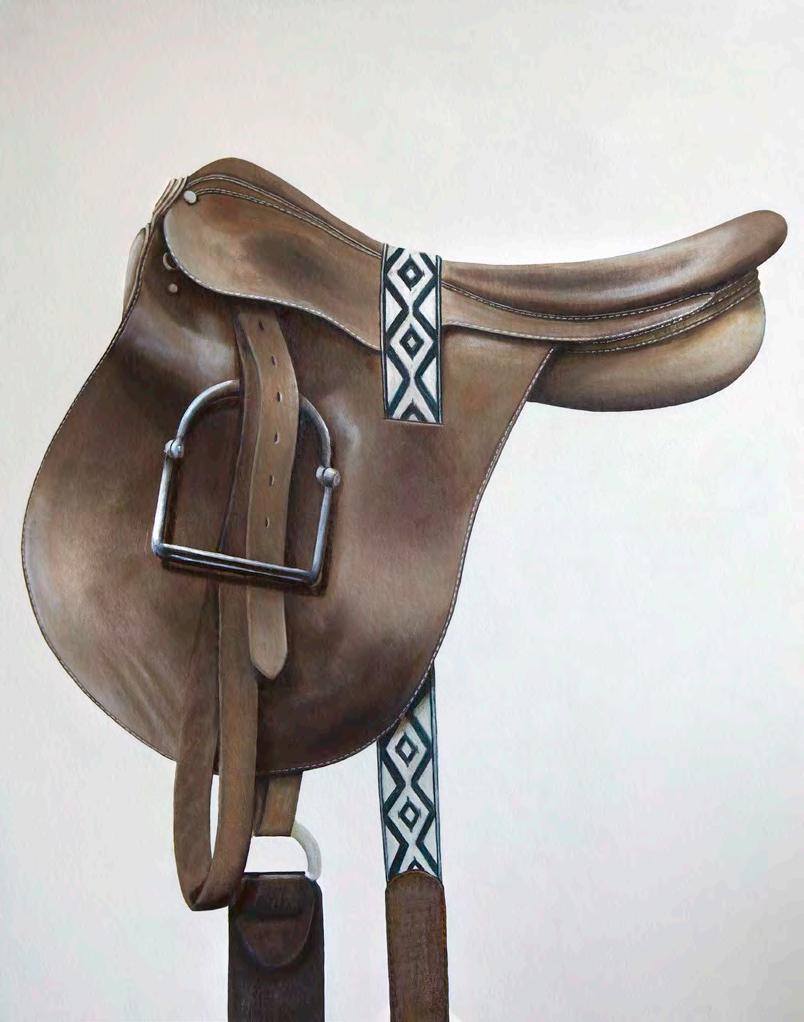
“I LIKE TO PORTRAY ATTITUDE AND PRESENCE IN MY SUBJECTS.”
88 | EQUESTRIAN LIVING | NOVEMBER/DECEMBER | 2022
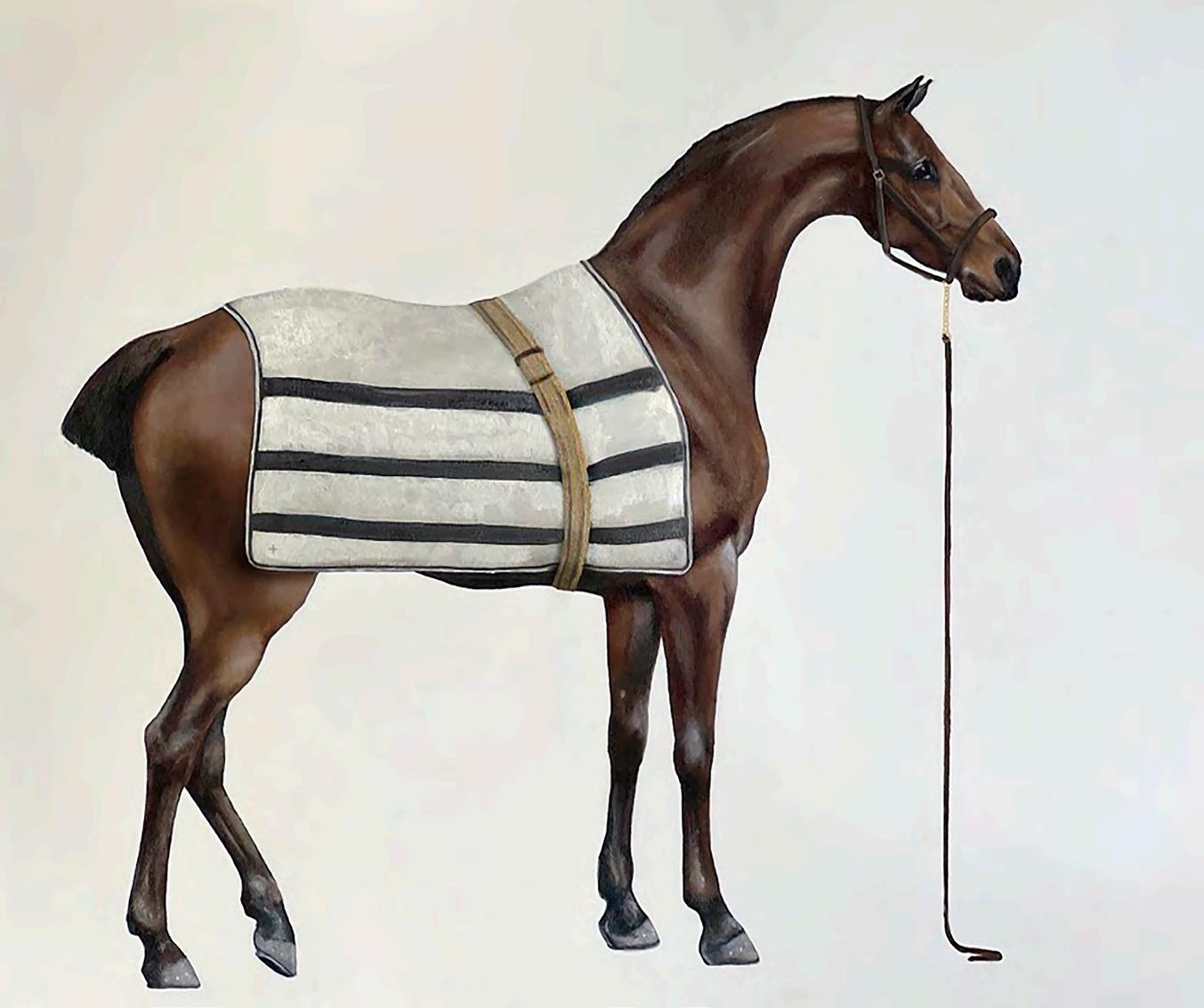
NOVEMBER/DECEMBER | 2022 | EQLIVING.COM | 89
photographers such as Annie Leibovitz, Tim Walker, and Sally Mann, although most would probably struggle to find a reference to those photographers in my work.
Where do you find subjects for your paintings?
Most of my friends own horses, so it’s been easy to access a variety of beautiful subjects.
Do you enjoy attending any famous U.K. events such as Ascot or Badminton Horse Trials?
I used to go to a lot of horse races in the U.K. My favorite would probably be in Cheltenham.
You also paint abstracts. Do you strongly prefer figurative, or are each equally as inspiring?
I’m pretty fickle, so it’s easy to flit between both styles. The level of concen tration needed to paint my horses can be tiring. For example, it took me six weeks to paint Freddie (see page 85), with most of the detail in his face, which was close to 10 feet above the floor. I was up on a ladder every day for weeks, so, at times, painting can be mentally and physically taxing.


90 | EQUESTRIAN LIVING | NOVEMBER/DECEMBER | 2022
continued from page 86 CONTACT INFO | PAGE 92

NOVEMBER/DECEMBER | 2022 | EQLIVING.COM | 91
DÉCOR
Page 22
Add a Touch of Festive Flair Bergdorf Goodman bergdorfgoodman.com Crate & Barrel crateandbarrel.com Equine Luxuries equineluxuries.com Frontgate frontgate.com Saks Fifth Avenue saksfifthavenue.com Terrain shopterrain.com
FASHION Page 24

Luxe Looks Callidae callidae.com Fendi fendi.com/us-en/ Hermès hermes.com Lafayette 148 lafayette148ny.com Nordstrom nordstrom.com Stick & Ball stickandball.com
Tension through the jaw and poll? Tight muscles? Uneven shoulders? Rotated ribcage or pelvis? Tilted head? Sudden spookiness? If the head is unlevel, then the eyes and the neurological input is altered. Now apply some of those examples to the comfort of your horse and the affect they would have on your horses’ performance. What would it mean in terms of stride length, impulsion, jumping, lateral movement, right rein vs. left rein, canter leads, circles, self-carriage, walking downhill….the list is endless. How can muscle develop evenly and correctly if the body is misaligned or forced into a position? How can an equine be comfortable when its muscles are burning, in contraction, and/ or spasm? How can they be expected to do what is asked, if they are physically incapable of doing so?
Force and obstruction break the perfect biomechanics of the body.
Arrive Looking Polished Page 30 Ariat ariat.com
Equines are no different from us: when you release pain and tension, you allow the entire body to rebalance and function fluidly; you give it the

opportunity to move with ease and therefore to the best of its ability.

Tension is counterproductive to effective balance and the harmony of free movement.

Parlanti parlantiinternational.com Tucci tuccitime.com Vogel vogelnyc.com
FOOD/DRINK Page 26
Prince & Pauper princeandpauper.com
PEOPLE Page 34 Yoga for Equestrians yogawithkassandra.com
STYLE Page 35 Objects of Desire Hermès hermes.com Longines longines.com/en-us Ralph Lauren ralphlauren.com
FAVORITES Page 36
Posture can be changed but conformation cannot, and these two elements should never be confused. Sports therapy may prevent and alter patterns of compensation by addressing alignment, muscle memory, tone and elasticity, connective tissue, and the equine system globally. Sports therapy may hasten healing of the muscle fibers, decrease nerve entrapment, reduce nerve-root compression caused by muscle tension, and stimulate nerves to help rejuvenate an injured part of the body. Stimulation of the nerve receptors have reflex reactions affecting the vasomotor nerves, visceral (internal) organs, pain perception nerves, and the underlying joints and muscles of the areas being treated. Change happens on a cellular level. Given what we ask of our horses, it makes perfect sense to have complementary therapies as part of the care of our horses.
For the Love of the Horse Mark Rashid Horse and Rider Books 2022

Page 44
Danny & Ron’s Rescue dannyronsrescue.org Life in the Dog House Book Series Simon and Schuster 2022 Available on Amazon TRAVEL Page 42 Equus Journeys equus-journeys.com
LYNN COAKLEY Page 68 EQUUS Foundation equusfoundation.org
A DAIRY BARN DREAM RENOVATION Page 80 kingbarns.com
When working with a sports therapist, remember that every horse is unique, and therefore sessions should always be individualized to that horse. It may take several sessions before the body starts to localize to your primary and secondary sites. There may be crossovers in types of treatment. In addition to massage, I may incorporate cranial therapy, myofascial release, trigger point therapy, Reiki, and positional releases and stretching. But a practitioner’s approach should never stop at the horse. There is often a larger environmental picture at play, and making a commitment to change requires a team effort.
EQUESTRIAN TECH Page 48 Prixview prixview.com

GALLERY Page 84 Sarah Payne sassyhardwick.co.uk @sassy_hardwick

Tradition and experience should never prevent us from continually learning and exploring possibilities to further understand our approach of the care and training of the horse. After all, we make every decision for them, so prevention is the best protection.
CECE BLOUM Page 60 Thrive Rescue thriveanimalrescue.com
BARN DOG Page 98 Jet Show Stable jetshowstable.com
92 | EQUESTRIAN LIVING | MAY/JUNE | 2022 EQ PEOPLE
CONTACT INFO | PAGE 94 EQUINE SPORTS THERAPY
SOCIAL MEDIAINNER CIRCLE EQLIVING.COMDIGITAL MAGAZINE PRINT EQUESTRIAN PROPERTIES EQUESTRIAN PROPERTIES IN WELLINGTON LUXURY LIVING AN INVITATION TO REALTORS REACH PROSPECTIVE BUYERS OF LUXURY EQUESTRIAN REAL ESTATE LEARN HOW EQLIVING CAN HELP: JOYCE JONES | JONES@EQLIVING.COM | 954-796-1809 92 | EQUESTRIAN LIVING | NOVEMBER/DECEMBER | 2022 Look for the symbol throughout the magazine to find out about featured products and services. WHERE TO FIND IT EQ RESOURCES

©ESIPhotography info@HITSShows.com | HITSShows.com | #ComeShowInFlorida



PHOTOS BY SHANNON BRINKMAN, BECKY PEARMAN PHOTOGRAPHY, DANIEL KAISER, LESLIE POTTER/US EQUESTRIAN, ANNAN HEPNER, PHELPS MEDIA GROUP, JUMP MEDIA, TAYLOR PENCE/US EQUESTRIAN Follow the Ride Supporting Athletes Promoting International Excellence Building for the Future Join the Team at USET.org (908) 234-1251

























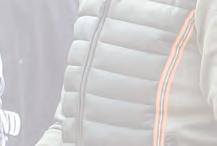









A LONG STRIDE BEYOND THE EXPECTED EQmedia.agency 612-209-0310 NAME ADDRESS CITY ZIP STATE EMAIL (Required for subscription updates.) TELEPHONE (Only in case of problems.) $45.95 FOR 2 YEARS | 12 ISSUES SAVE $49 * $28.95 FOR 1 YEAR | 6 ISSUES NEW SUBSCRIPTION RENEWAL EQ UESTRIANTR A VEL | DES IGN | PE O PL E ST YLE | F AS HI ON | D ECOR ® eqliving.com LI VIN G Include a check with this coupon: (USA only; other countries please use website) Mail coupon with your check to: EQ LIVING MAGAZINE BOX ONE BROWNSVILLE, VT 05037 *Off of newsstand price. SUBSCRIBE TO THE BEAUTIFUL PRINT EDITION To pay by CREDIT CARD , please go to www.EQliving.com/subscribe Allow 6-8 weeks for your first copy to arrive. A LONG STRIDE BEYOND THE EXPECTED EQ MEDIA The full-service media agency with an equestrian focus EQmedia.agency 612-209-0310 Planning and Strategy Public Relations Marketing Branding Event Promotions Event Press Centers Email Marketing Social Media Websites Graphic Design Video Production Podcasts Sponsorship Support Product Launches Book Tours NAME ADDRESS CITY ZIP STATE EMAIL (Required for subscription updates.) TELEPHONE (Only in case of problems.) $45.95 FOR 2 YEARS | 12 ISSUES SAVE $49 * $28.95 FOR 1 YEAR | 6 ISSUES ––NEW SUBSCRIPTION RENEWAL EQ UESTRIANTR A VEL DES IGN PE O PL E ST YLE F AS HI ON | D ECOR ® eqliving.com LI VIN G Include a check with this coupon: (USA only; other countries please use website) Mail coupon with your check to: EQ LIVING MAGAZINE BOX ONE BROWNSVILLE, VT 05037 *Off of newsstand price. SUBSCRIBE TO THE BEAUTIFUL PRINT EDITION To pay by CREDIT CARD , please go to www.EQliving.com/subscribe Allow 6-8 weeks for your first copy to arrive. May_22_ads.indd 97 8/16/22 1:13 PM
GINGER, POPPY, AND WOLFIE
Meet the dogs of the TORANO FAMILY.
 BY DANIELLE TORANO
BY DANIELLE TORANO
Jimmy Torano oper ates the hugely successful JET Show Stable based in Wellington, Florida, and Mohrsville, Pennsylvania. JET Show Stable offers premier training, showing, and sales services. He frequently visits Europe and is one of the nation’s top importers of up-andcoming young show jumpers, equitation, and hunter prospects. Many of today’s champions were originally imported by Jimmy. He is also a Big “R” judge who has judged many major classes. His wife, Danielle, is one of the top ama teur-owner hunter and jumper riders in the history of U.S. show jumping who has earned tri-color ribbons at all the nation’s most pres tigious events.
Ialways had big dogs when I was growing up, and we got Jack Russells when I was probably 12 or 13 years old. We ended up breeding one and had a million puppies. I remember them all being in a playpen in our house.
Jimmy didn’t have dogs growing up. But when we first got married, I wanted a dog really badly. We were at one of the indoor shows, and there were Jack Russell puppies for sale. We were staying at a very nice hotel, and Jimmy said that if the hotel would take dogs, I could get one. I’m sure he was thinking that there was no way the hotel was going to take dogs, but they did.
So we started with that one, Jimmy’s first, and then at one point we ended up
with three. This was before kids, and suddenly they were like Jimmy’s kids. He would wake me up in the middle of the night and say, “Oh my gosh, look at the way Buddy is sleeping.” He went crazy for little dogs, and then we had kids, and we continued to have dogs.
Later, we got two big dogs from Danny & Ron’s Rescue from their Hurricane Katrina project. They were huge, like small ponies. They were named Cheech and Chong. I think Ron called me because they knew we had the farm, and they wanted to keep them together. That was our first dealing with Danny & Ron’s dogs.
Later, I told Kim Tudor, Danny and Ron’s director of marketing, that we wanted a Pomeranian. I wasn’t sure we’d ever get one, but a few months later, she called. Of course, now the Pomeranian, Wolfie, is my dog.
They also had a Jack Russell. It was Christmas time, and we had lost our other Jack Russell not long before. We’re
not sure how old she was because she was abandoned in an apartment.
It’s almost impos sible to say in words what Danny & Ron do. They’re so tal ented in taking care of the dogs and in matching them with the right new owners.
Wolfie has become a one-person dog. He’s my little guy, and he defi nitely has little dog syndrome. He acts like he’s a big dog. If someone comes through the door, he runs out and acts like he’s going to eat them alive, and then he turns around and comes back in. But he definitely wants people to think he’s big and scary.
On the other hand, I think Ginger might go with anybody. She makes you feel like you are the only person in the universe. She’s very needy, and she wants a ton of attention. She is a people-dog like I’ve never had before. She can’t get close enough to you. She literally wants to go through you.
With adopting the puppy, Poppy, I lost sleep a couple of nights thinking, “What am I doing? How am I gonna bring a puppy into this house? Ginger is going to think it’s a rodent.” But now I say to the kids every day, Ginger is turn ing her into her clone. This dog does everything she does.
People ask if Jimmy has a favorite. He always jokes that I would say it’s prob ably Ginger because Ginger acts like his dog, but then again, she acts like she’s everybody’s dog.
VICCI VALENTI/KIND MEDIA
Jimmy, JJ with Ginger, Natalia with Poppy, and Danielle with Wolfie.
CONTACT INFO | PAGE 92 98 | EQUESTRIAN LIVING | NOVEMBER/DECEMBER | 2022 EQ BARN DOGS


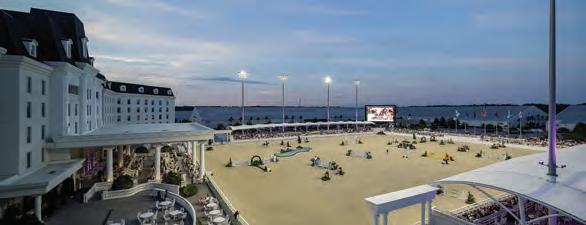











 © ANDREW RYBACK
© ANDREW RYBACK
2022
See

TAKE THE
LEAD
what’s possible in the all-new Gulfstream G400™. Redefine 21st century business success with a breakthrough combination of performance, environmental efficiency and the largest cabin in the class.






















































 COURTESY WYNN HOTELS
LA GOUTILLON
COURTESY WYNN HOTELS
LA GOUTILLON



















































 JESSICA
NOTARGIACOMO
JESSICA
NOTARGIACOMO





































































































 PHOTOS THIS SPREAD CHASE HALL
PHOTOS THIS SPREAD CHASE HALL





 CeCe Durante Bloum with Hef and Bo at Newmarket Farm, home to Thrive Animal Rescue.
CeCe Durante Bloum with Hef and Bo at Newmarket Farm, home to Thrive Animal Rescue.








 JILL
JILL












 ARCHITECT: MARK FINLAY, PHOTOS: WARREN JAGGER
ARCHITECT: MARK FINLAY, PHOTOS: WARREN JAGGER










 PHOTO BY SPORTFOT
PHOTO BY SPORTFOT




 WITH JOHN KING, OWNER, DESIGNER, KING CONSTRUCTION
WITH JOHN KING, OWNER, DESIGNER, KING CONSTRUCTION






 Artist Sarah Payne seated in front of her painting, Scarlett.
Artist Sarah Payne seated in front of her painting, Scarlett.

















































 BY DANIELLE TORANO
BY DANIELLE TORANO














 © ANDREW RYBACK
© ANDREW RYBACK
